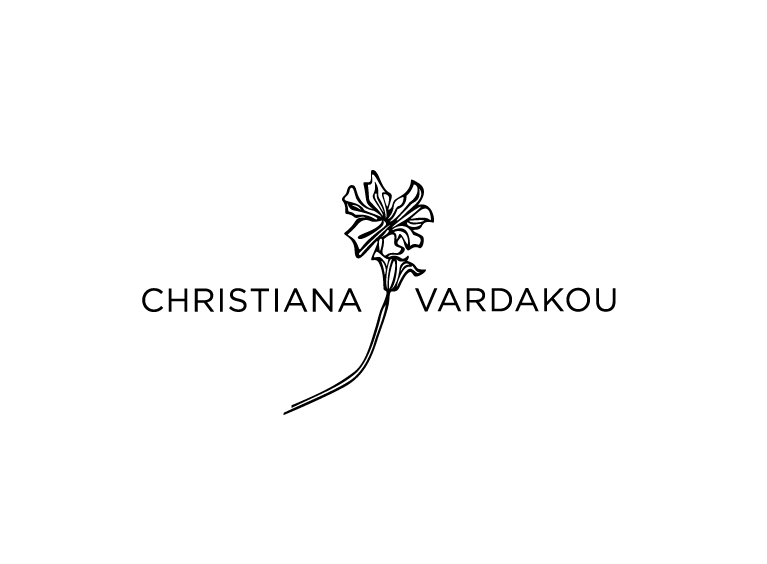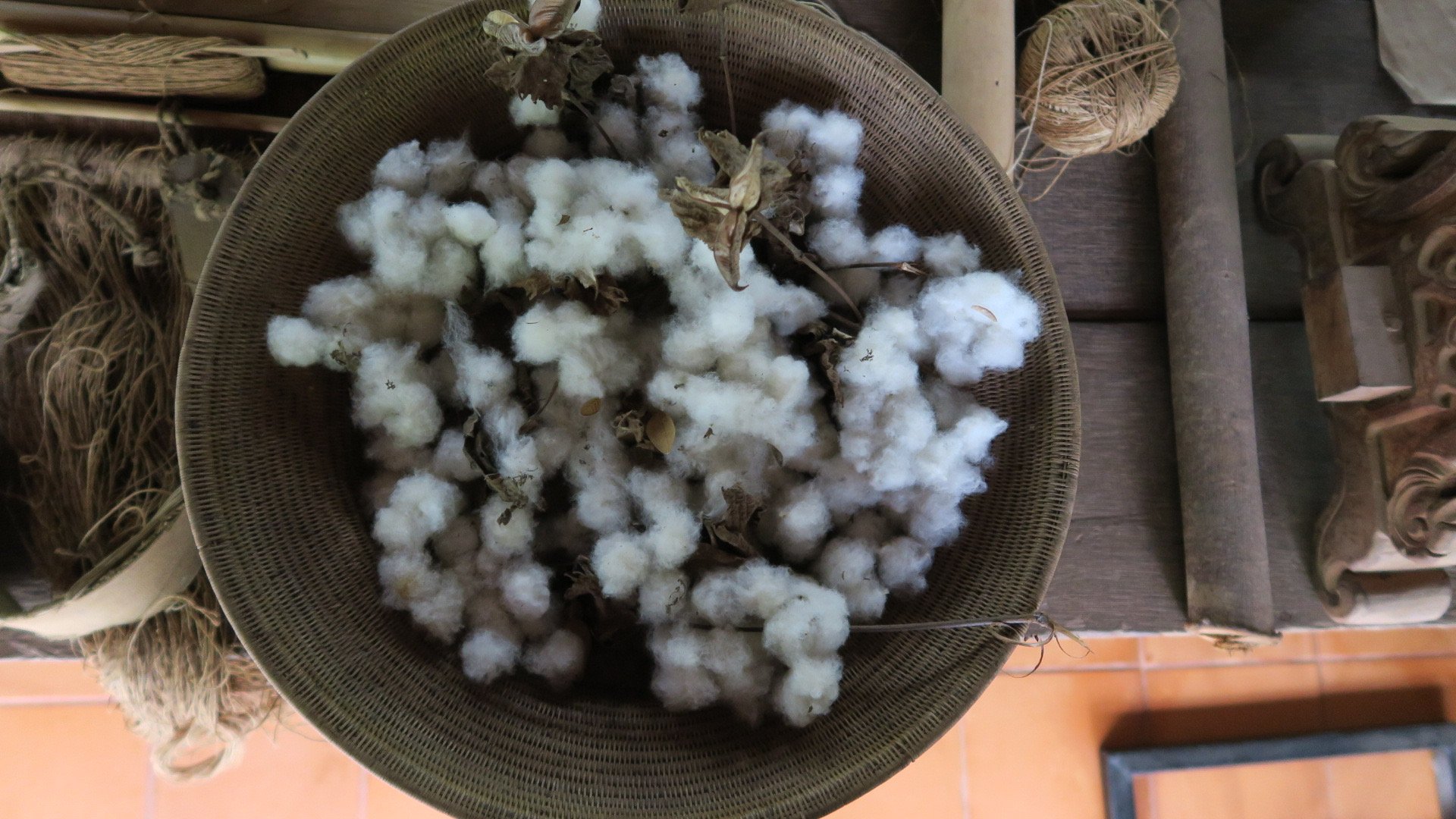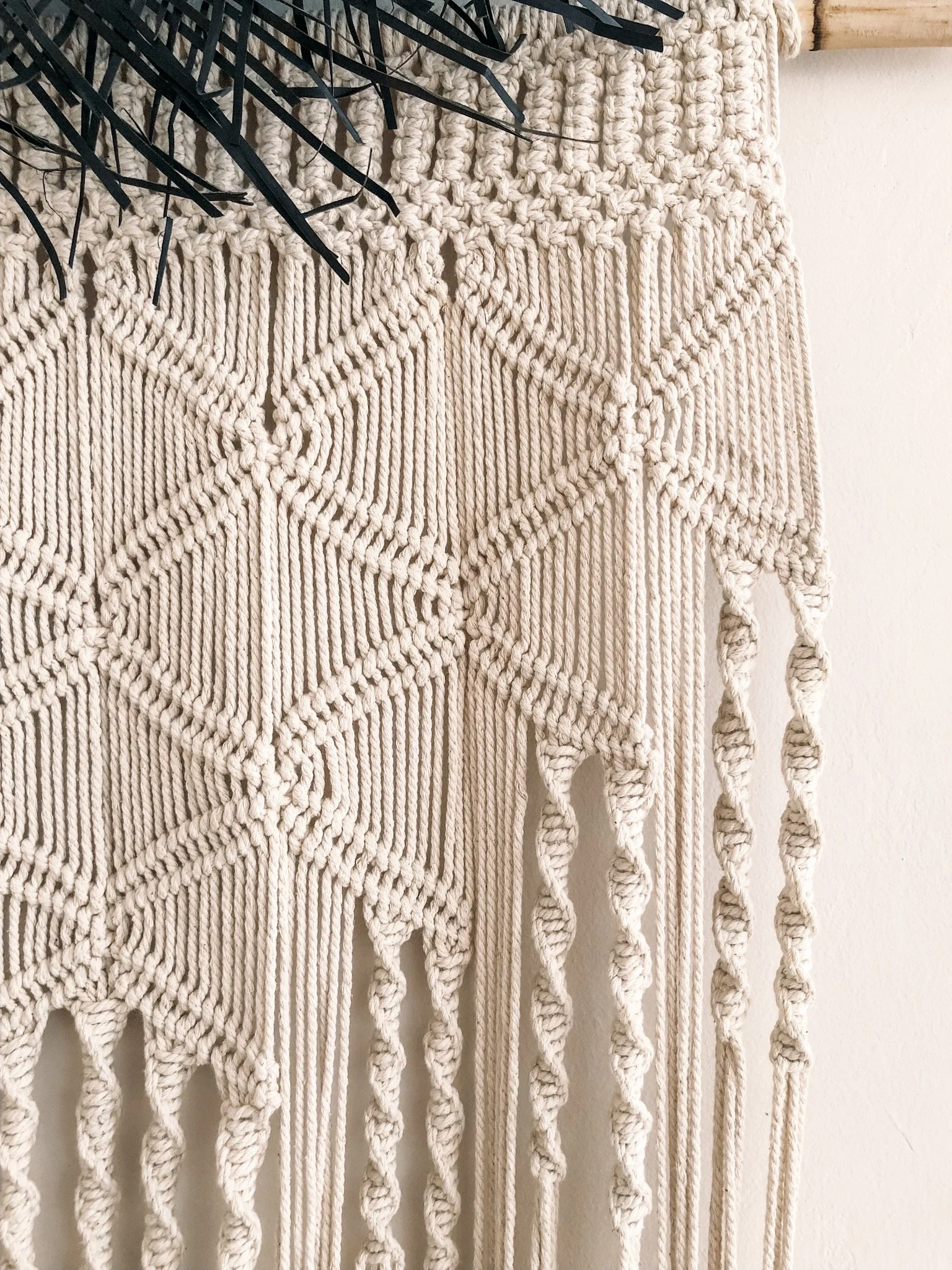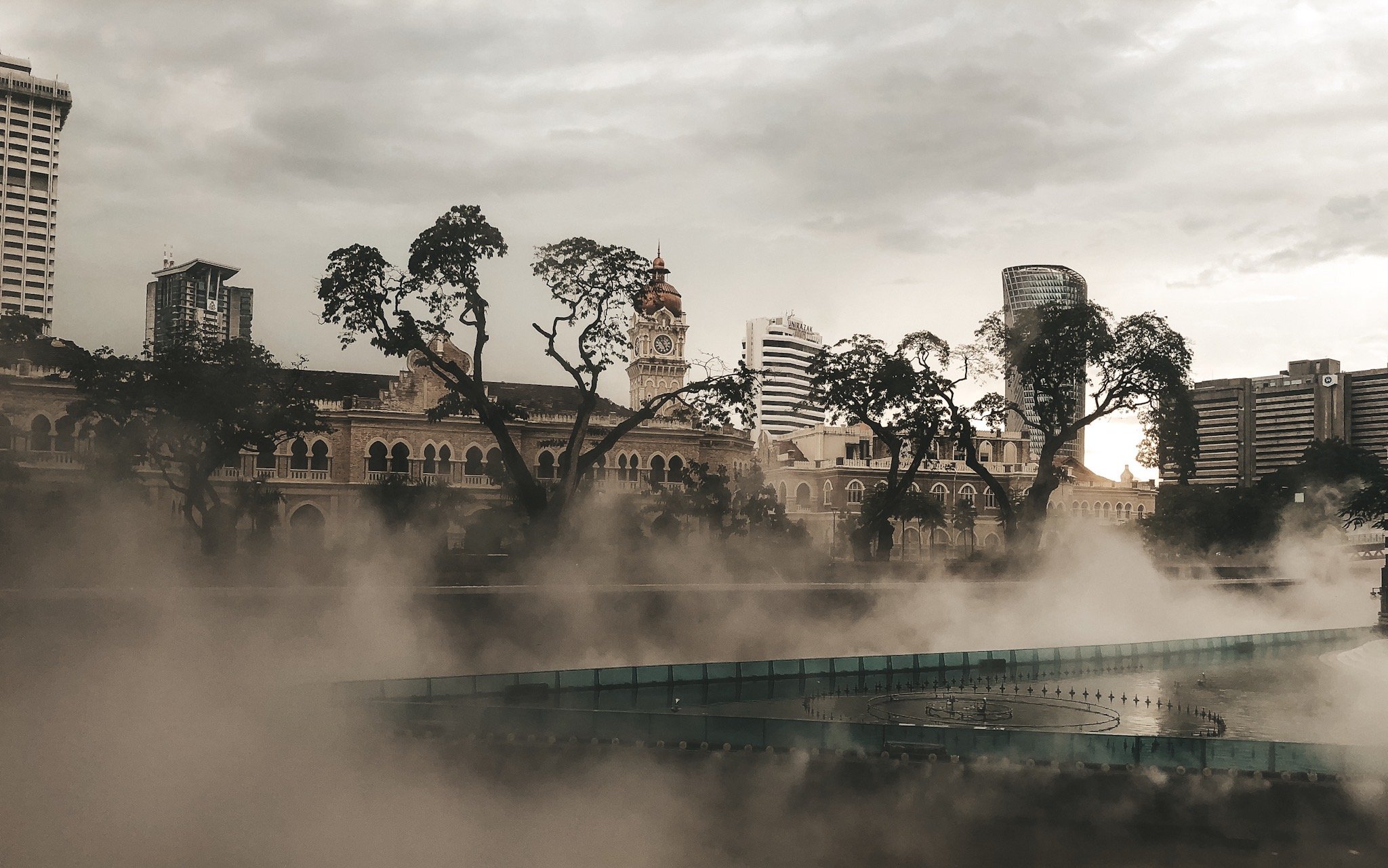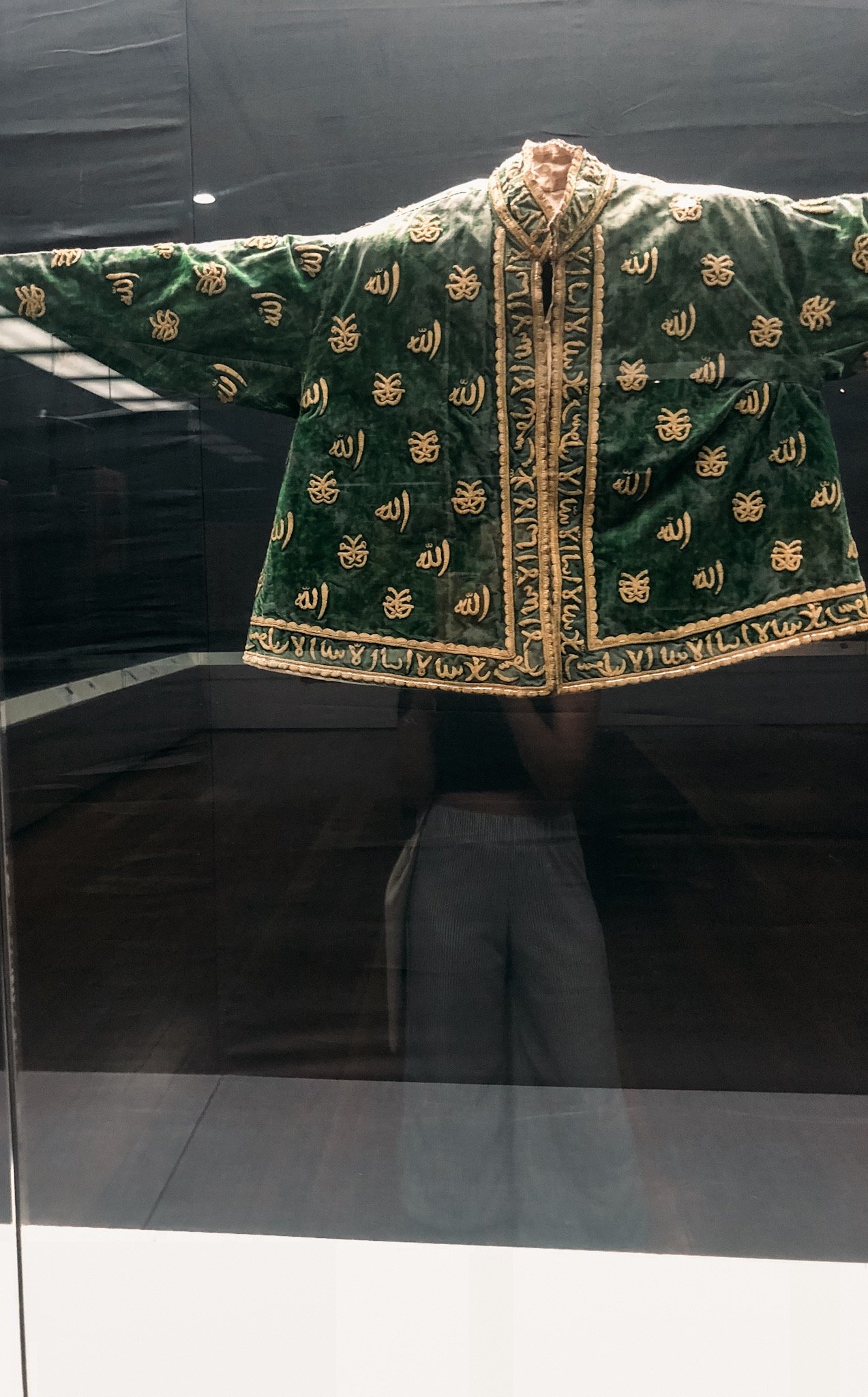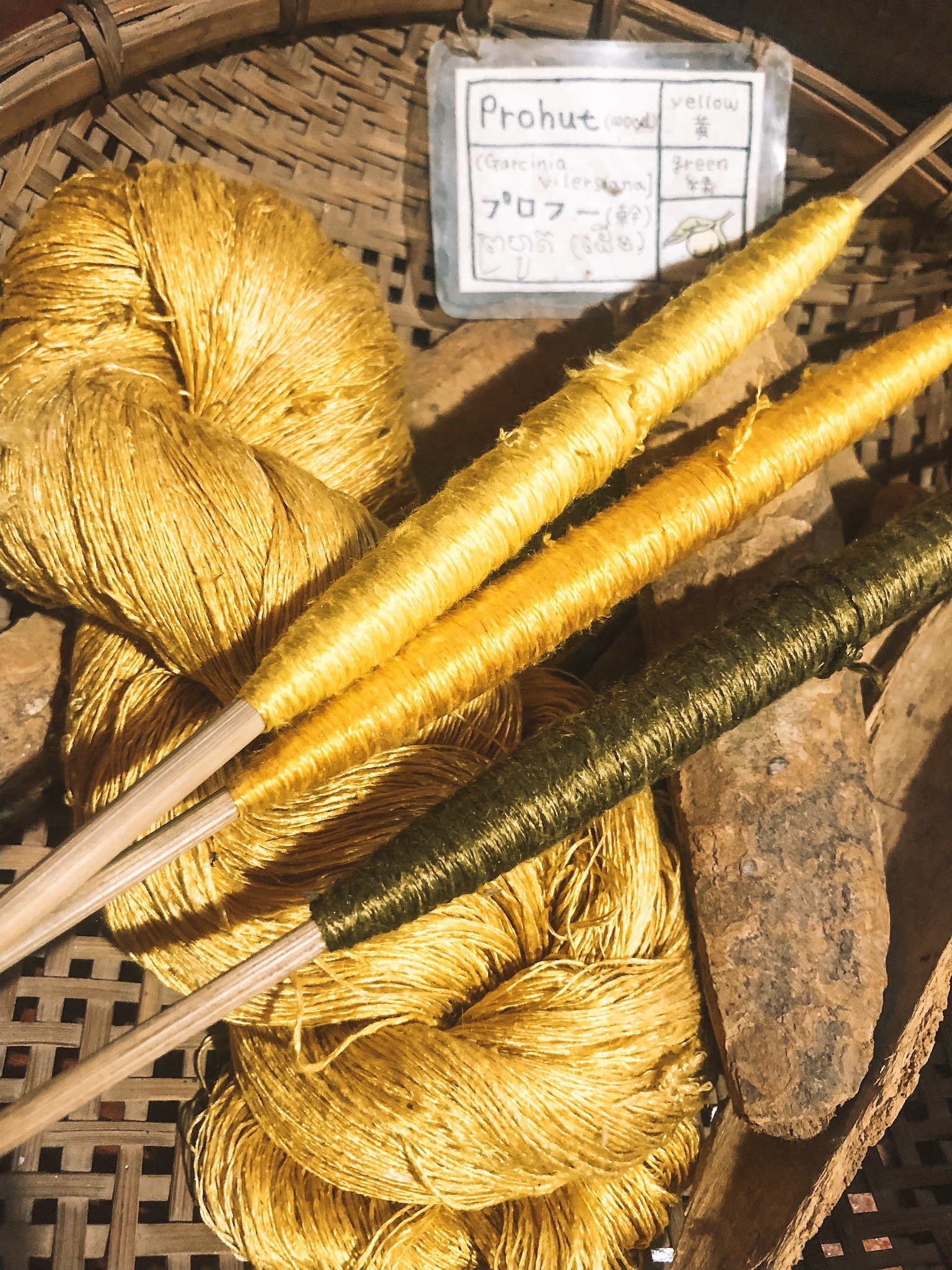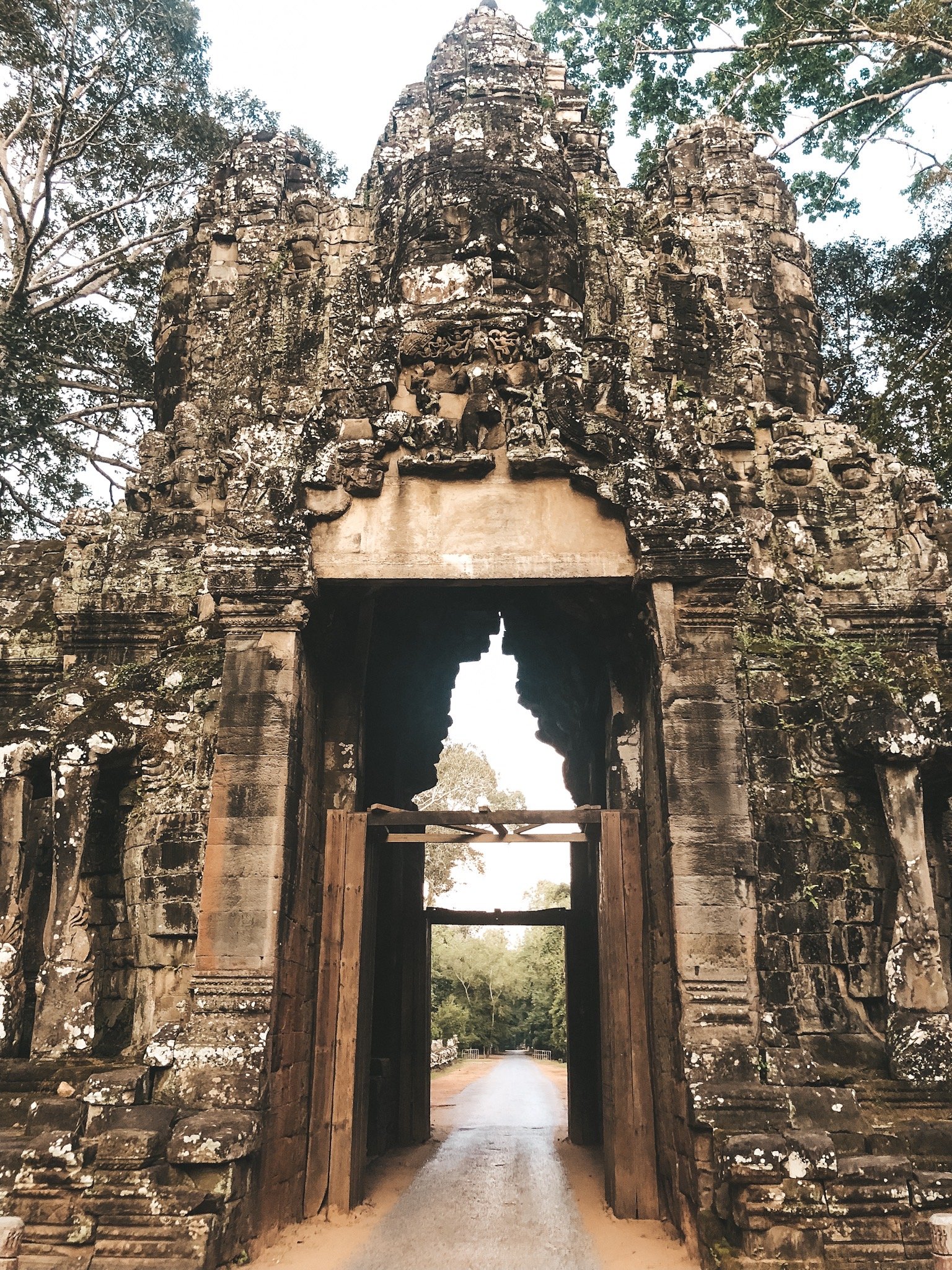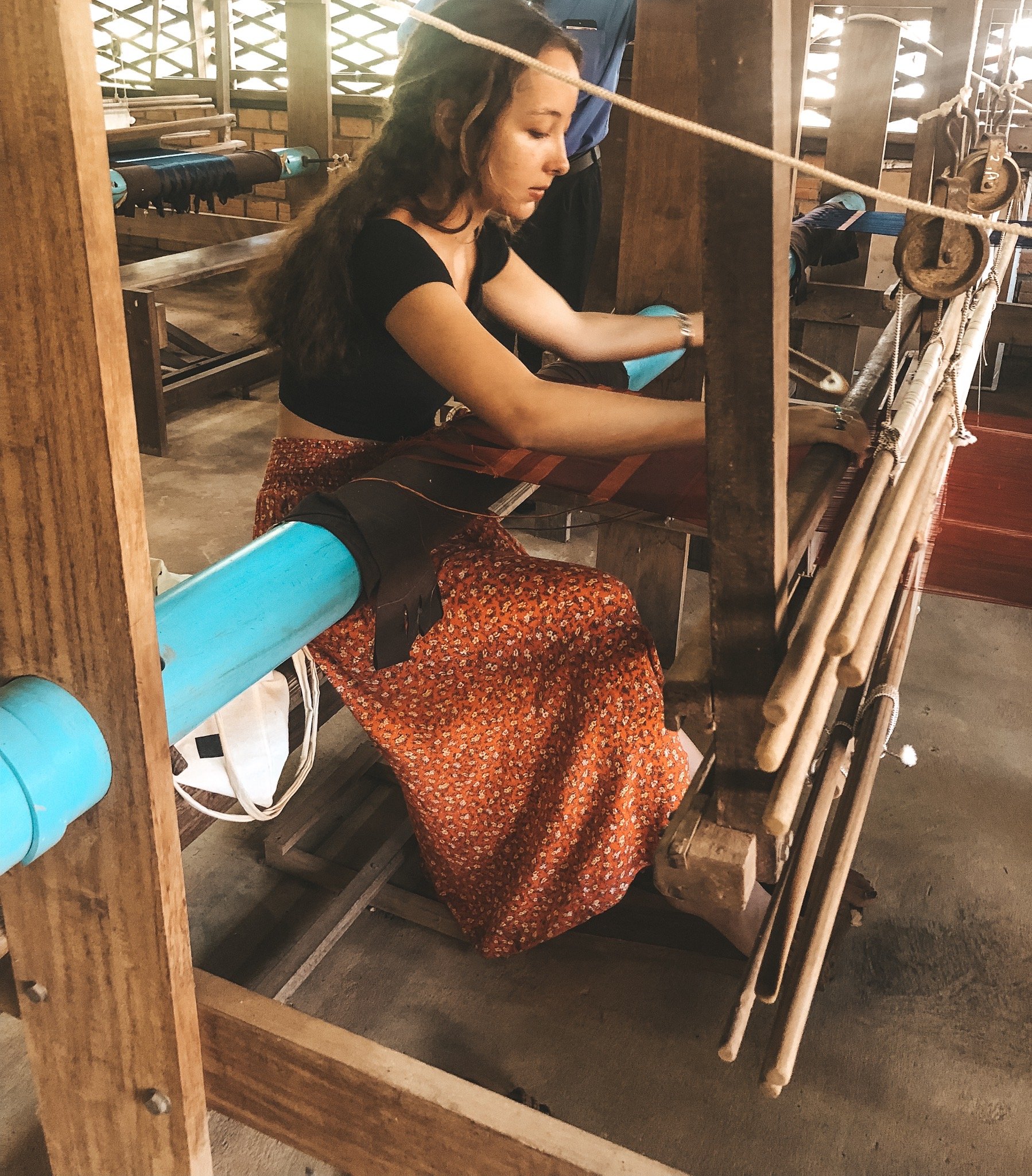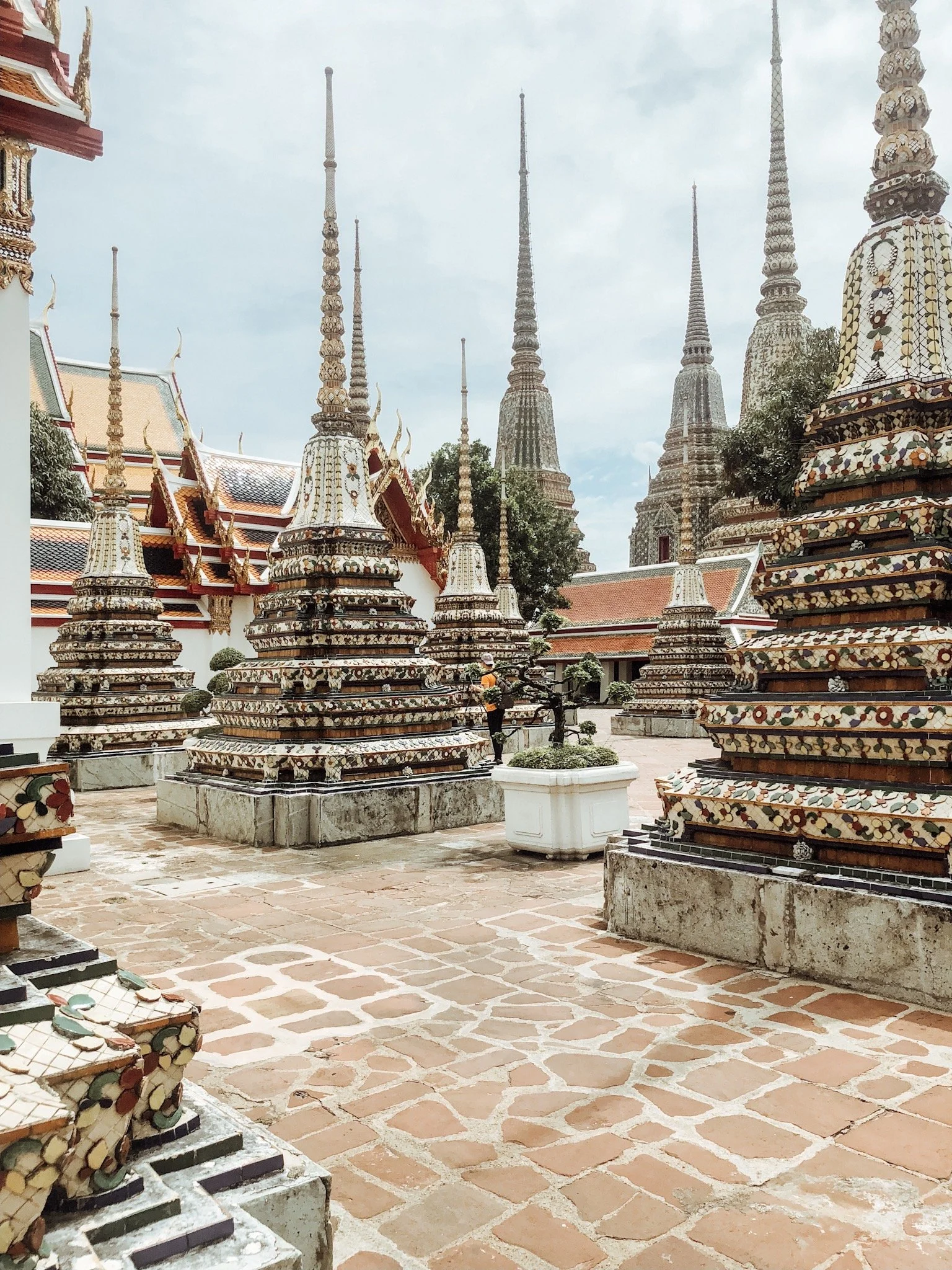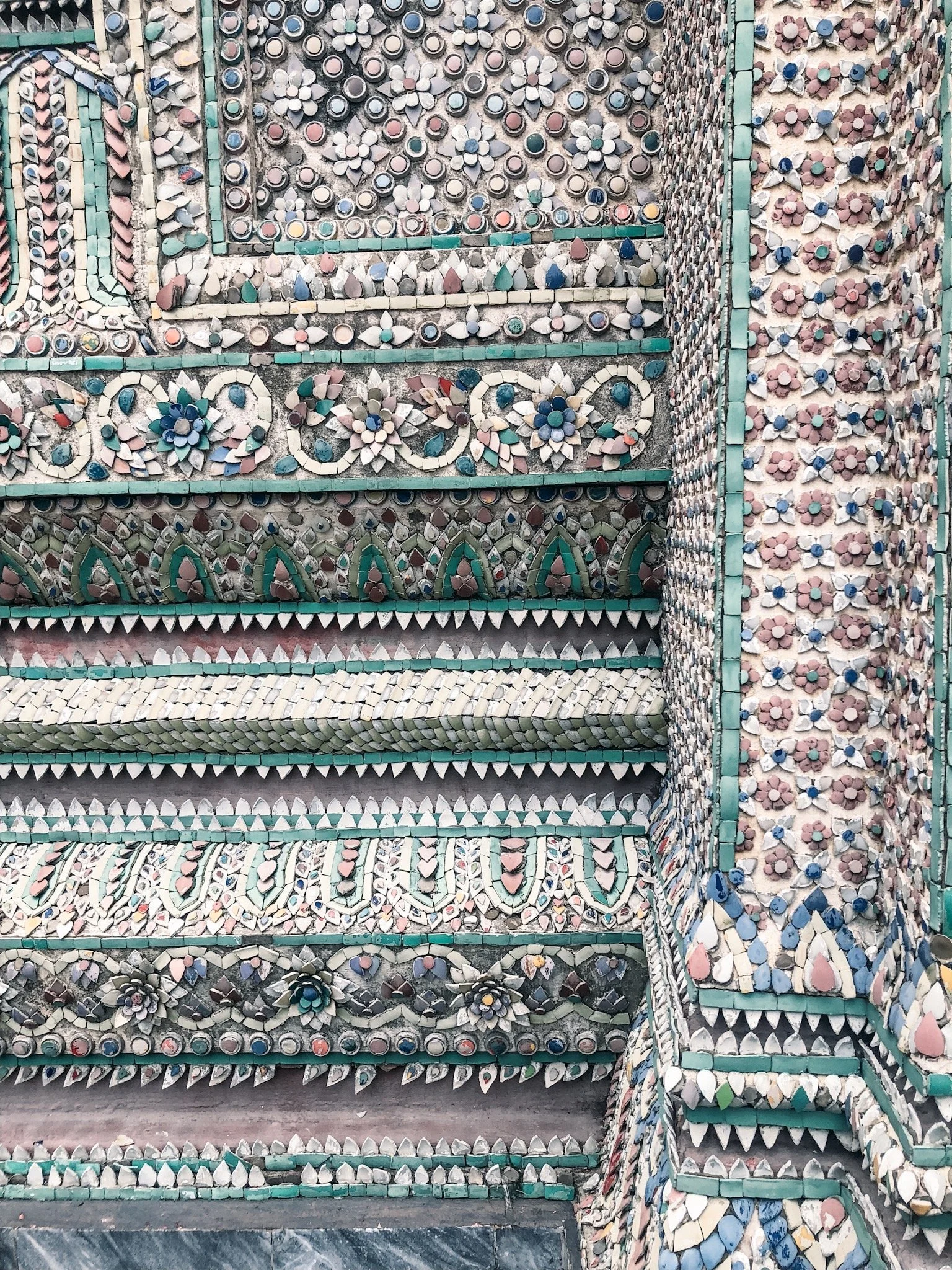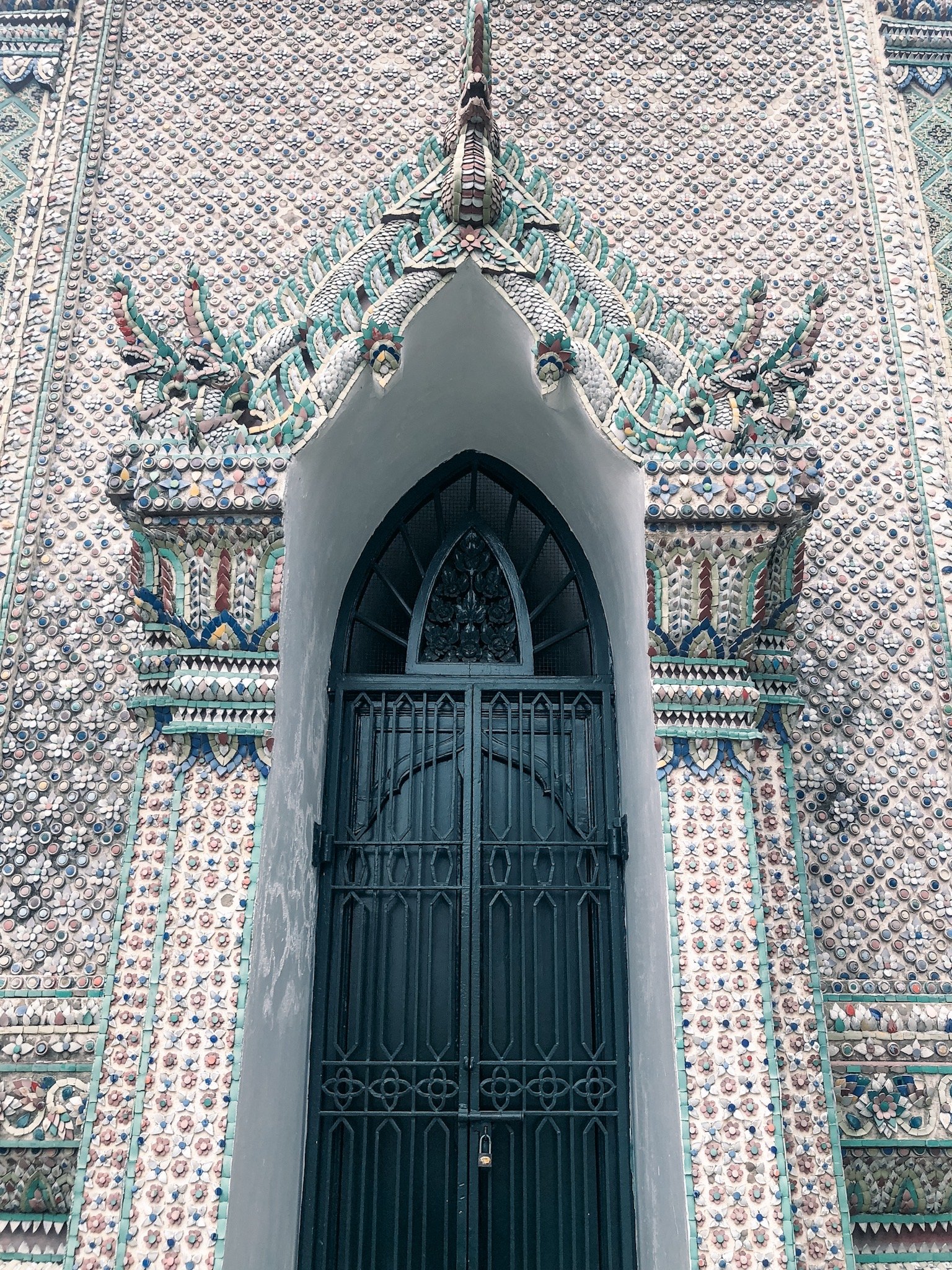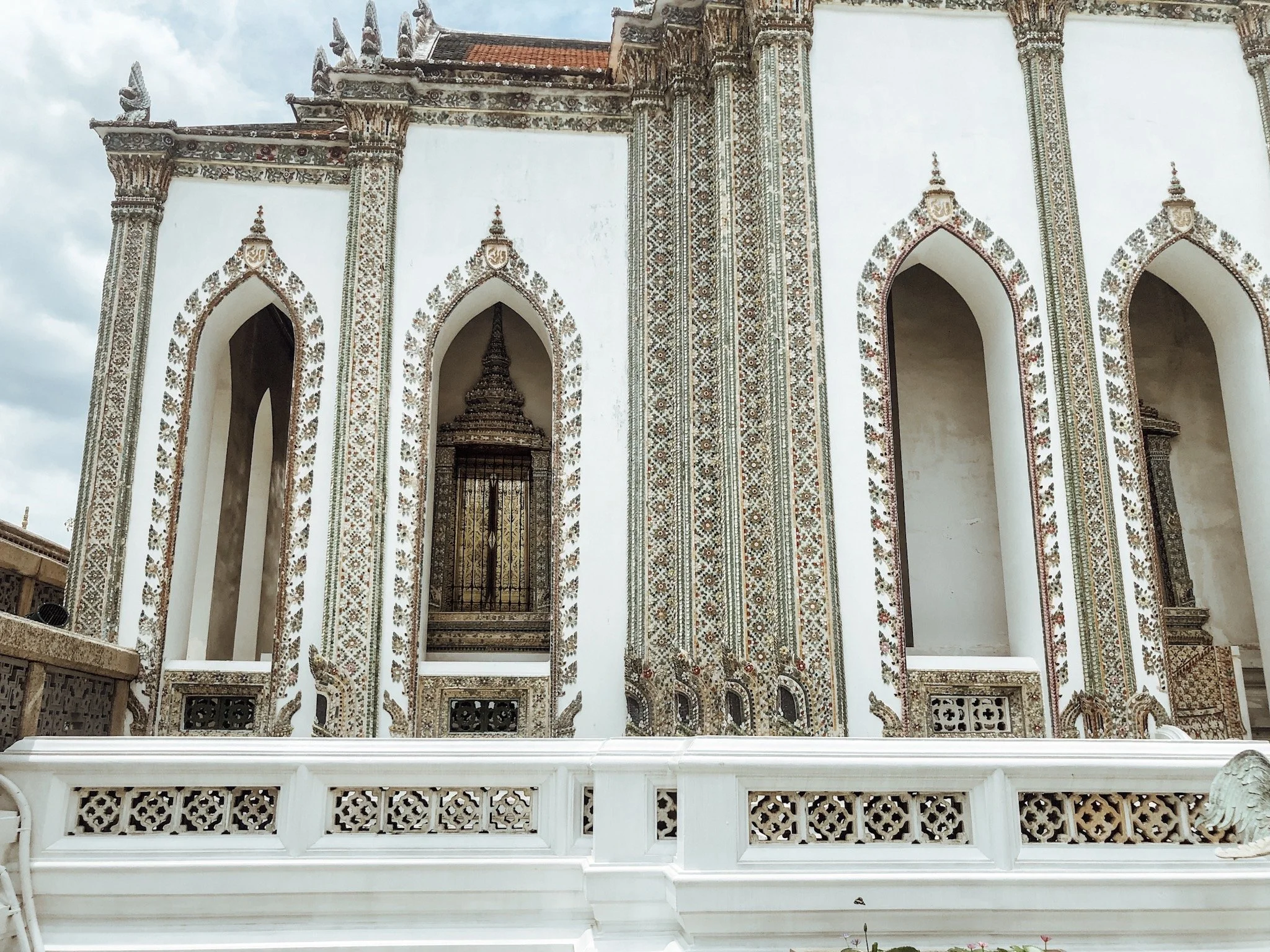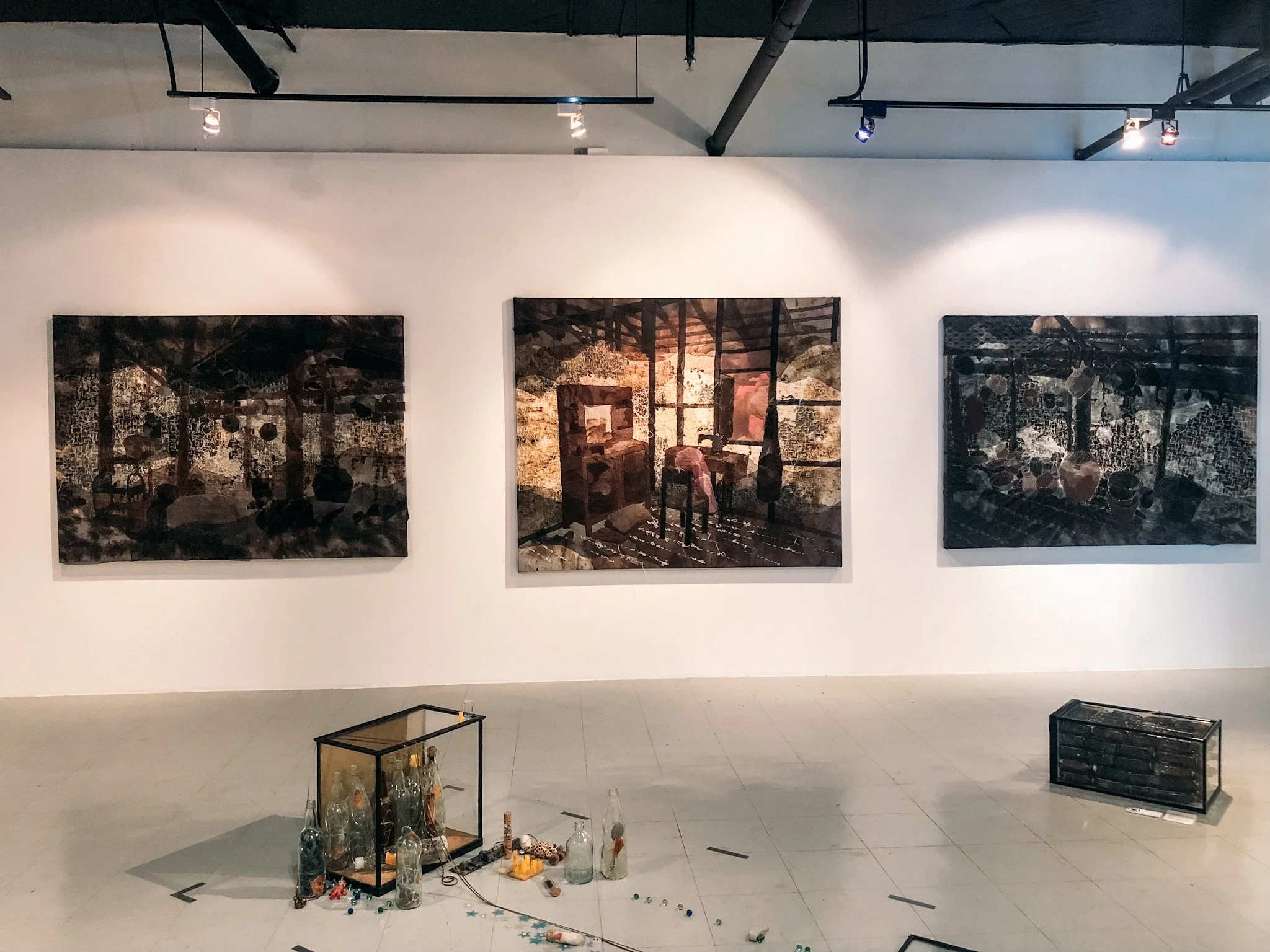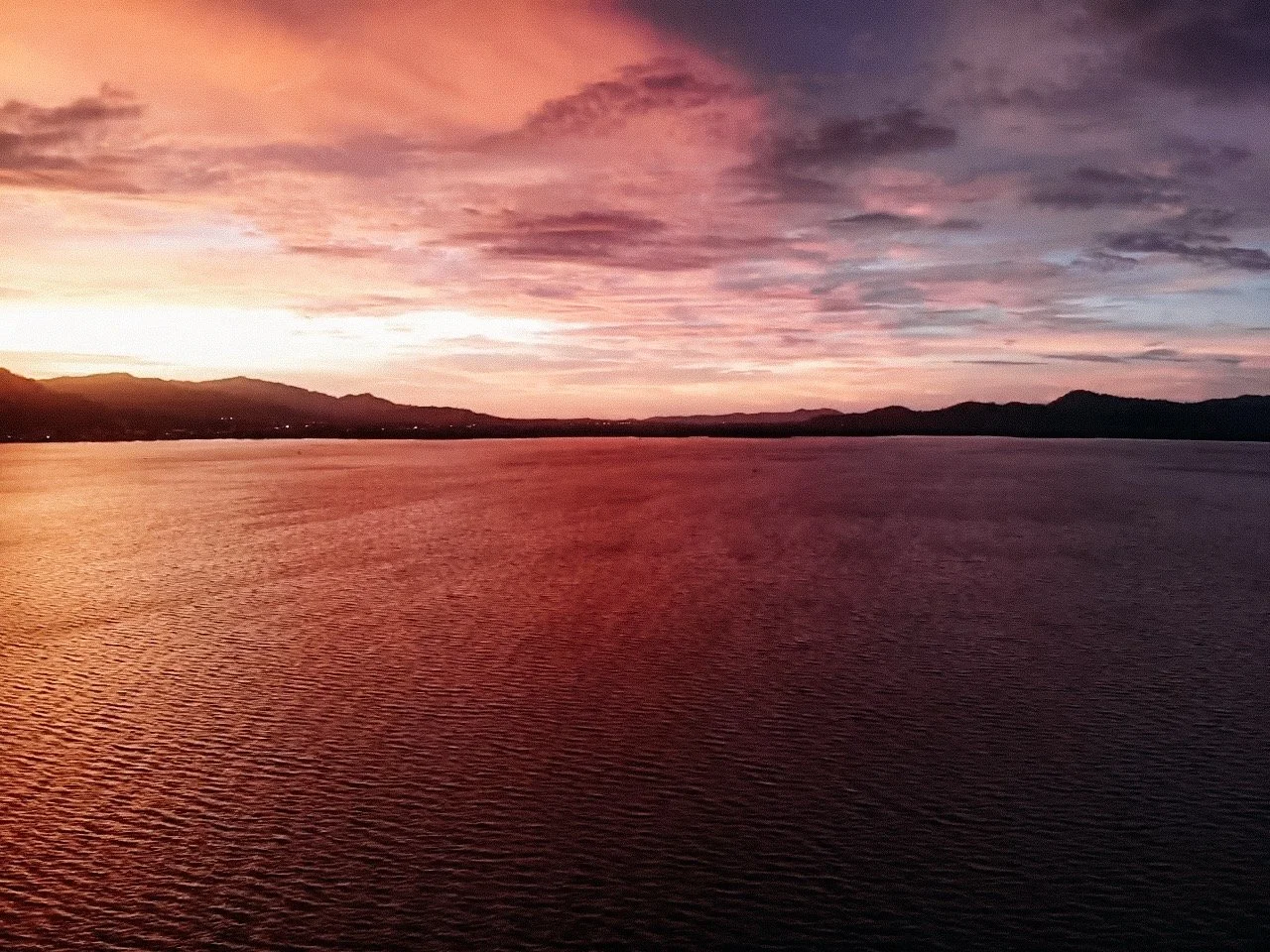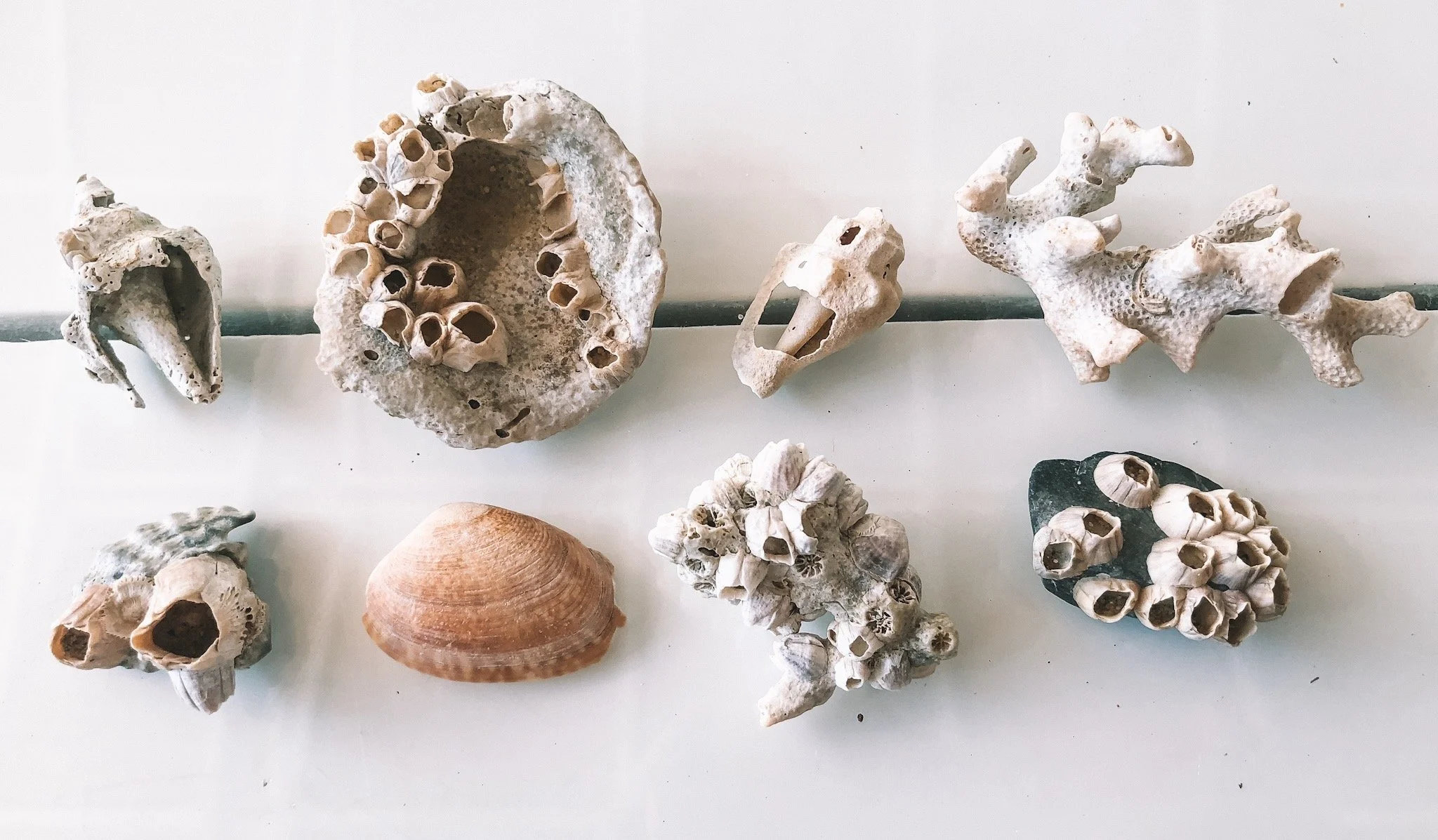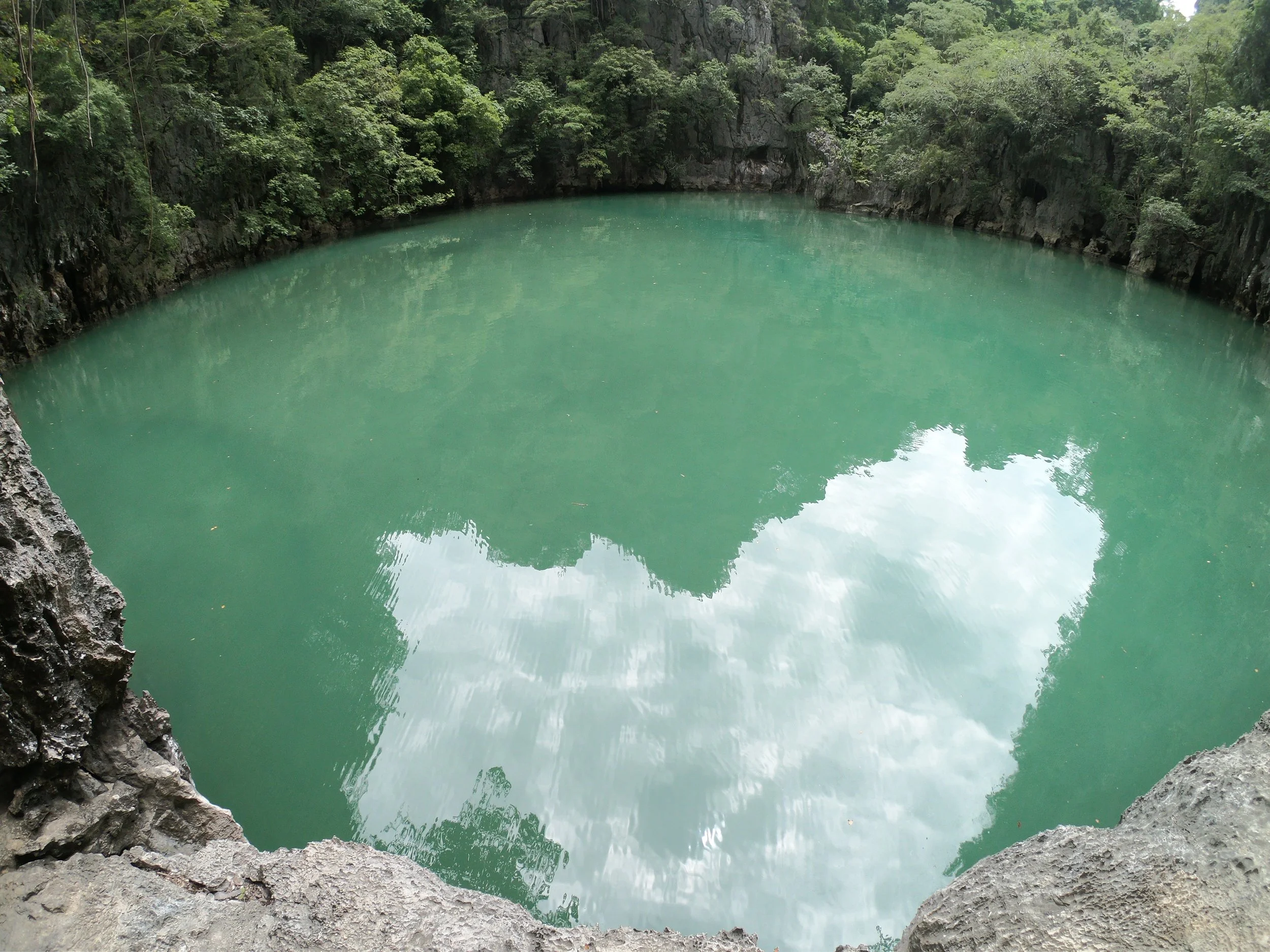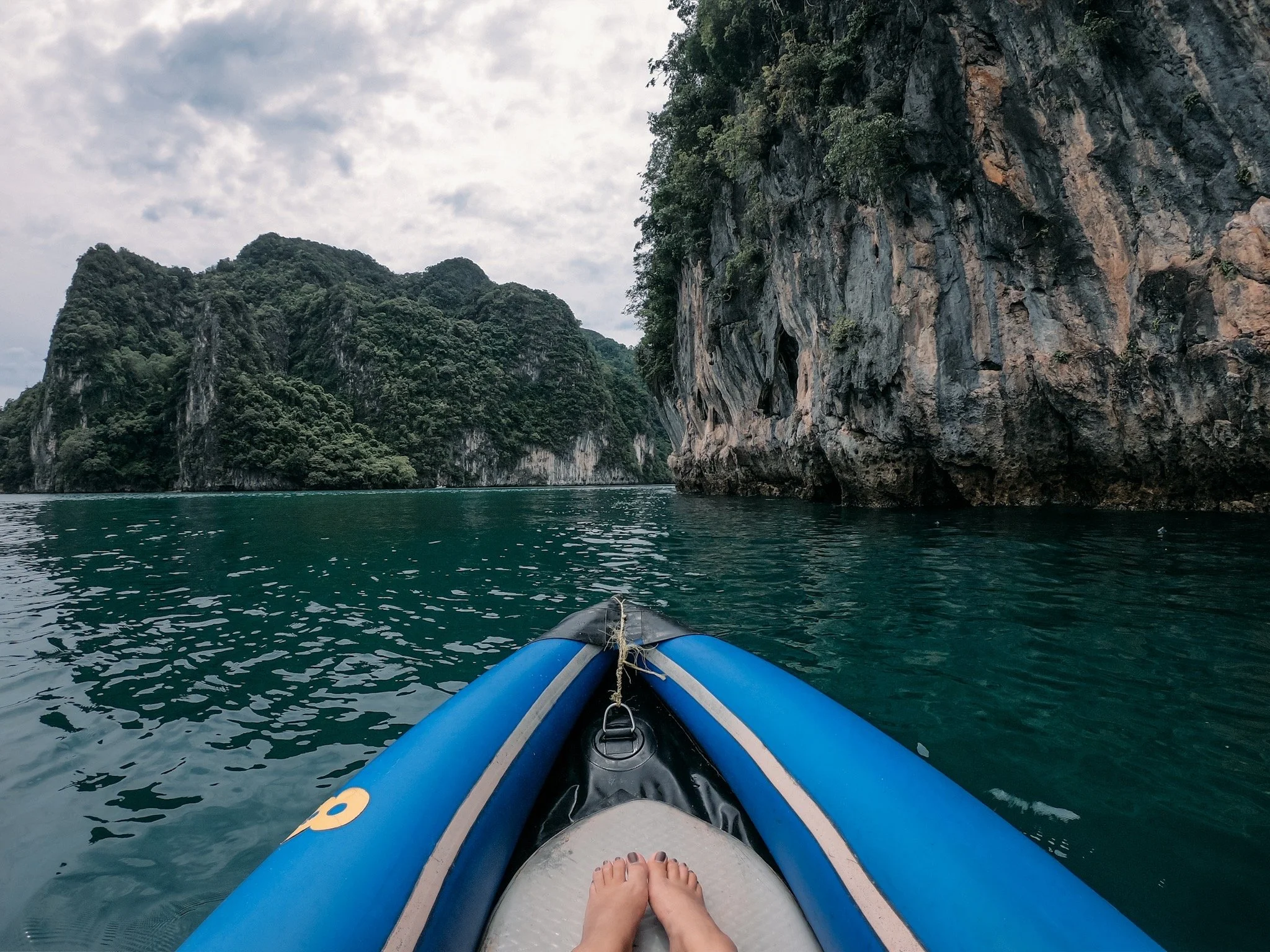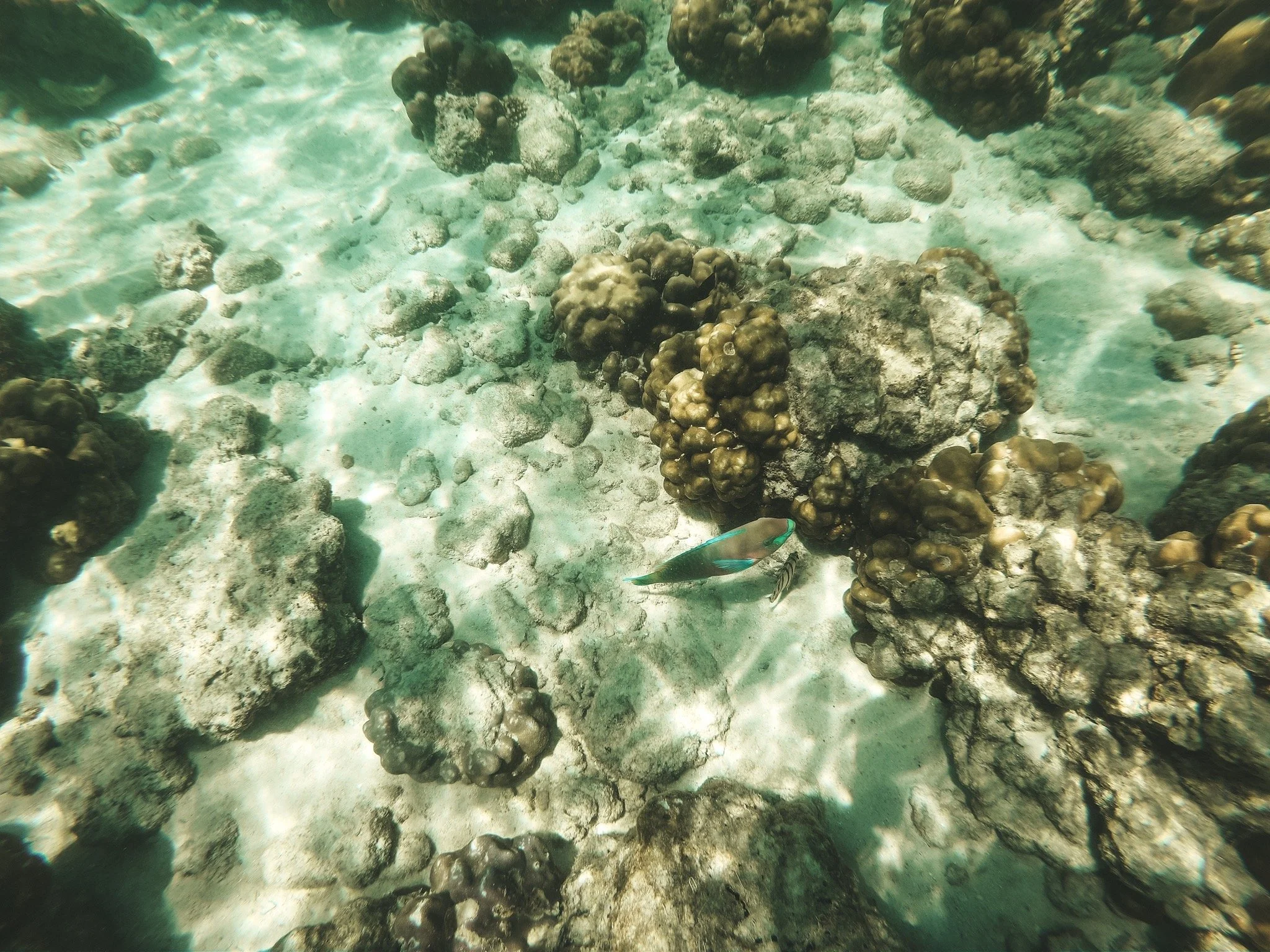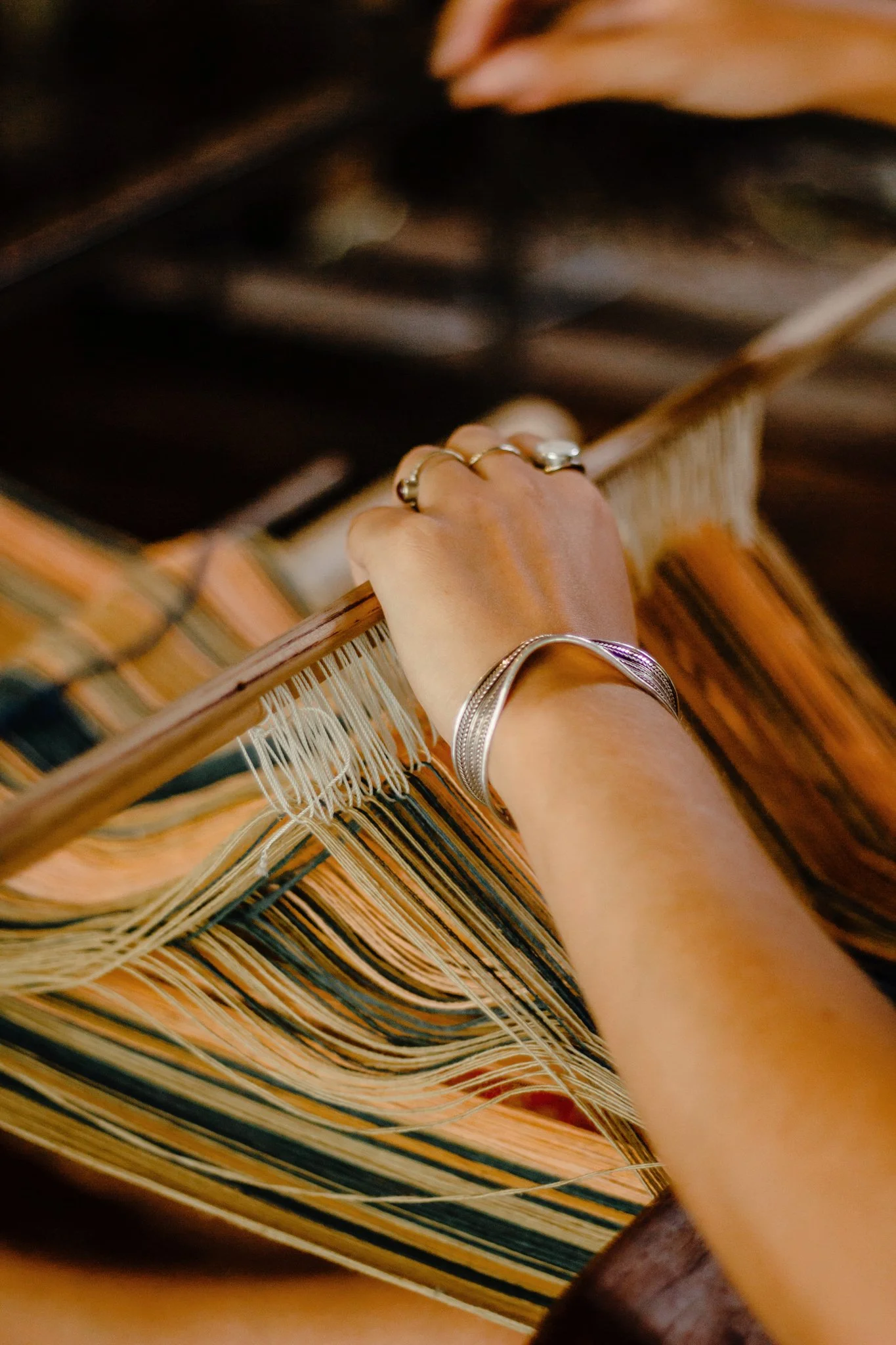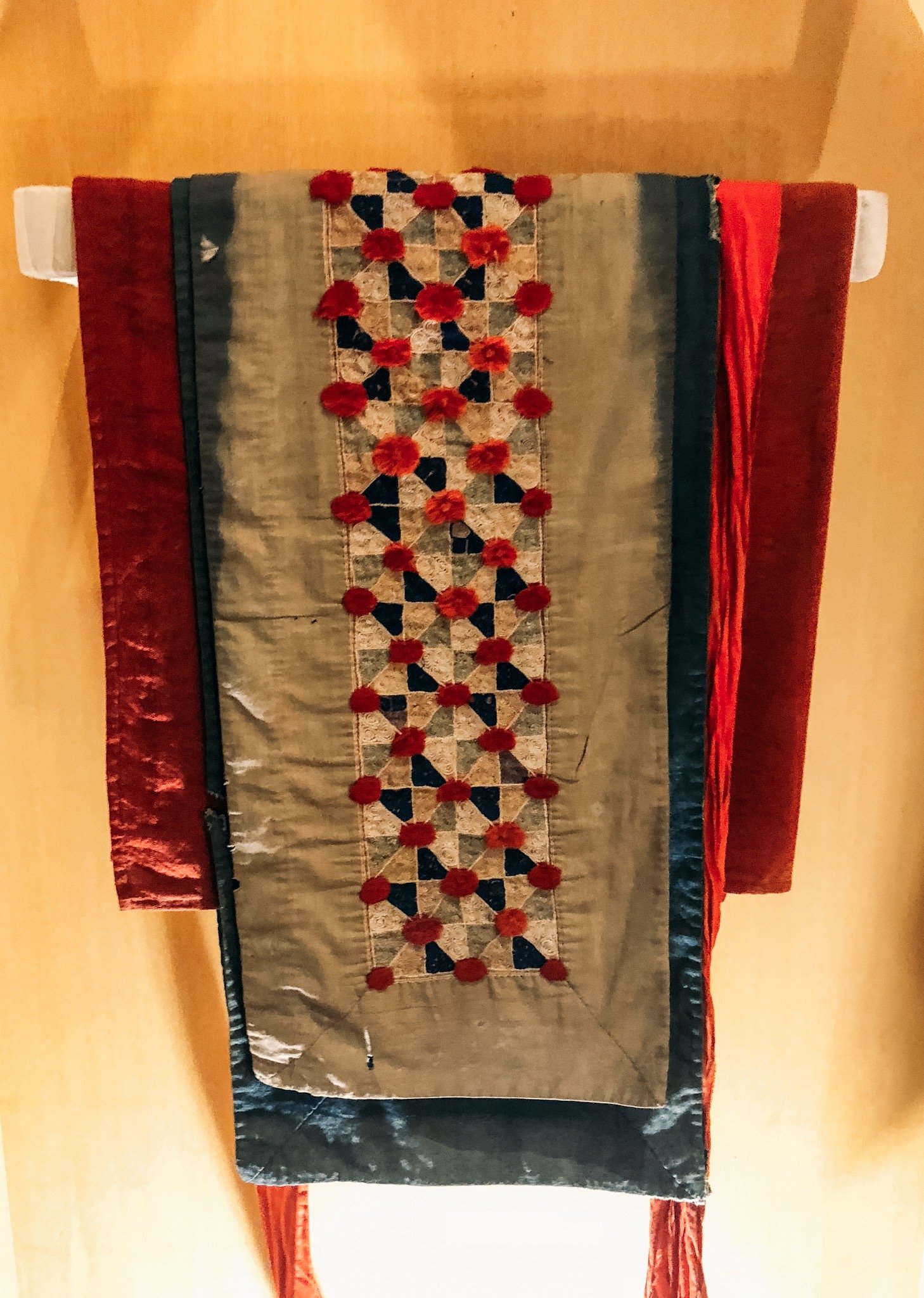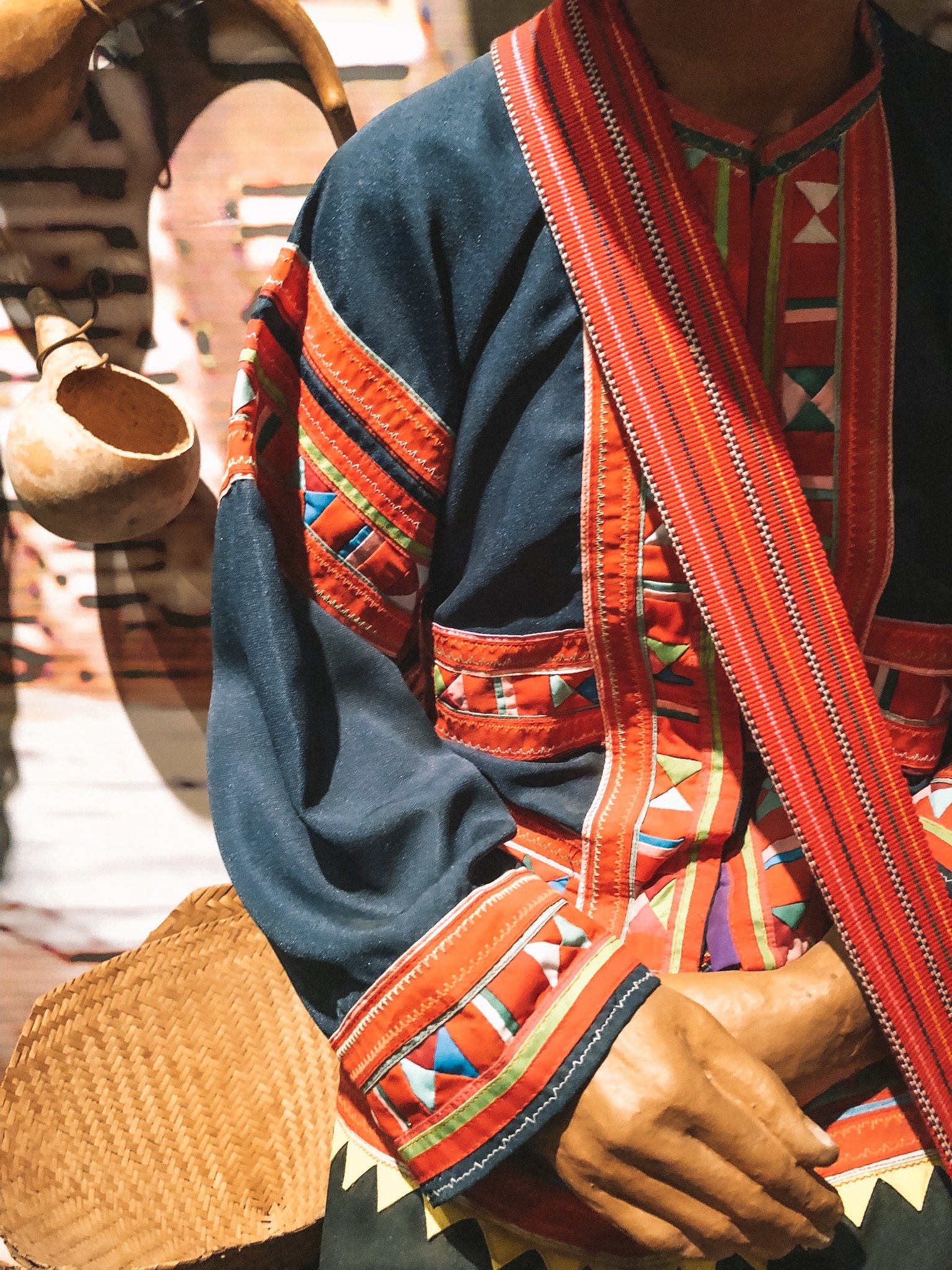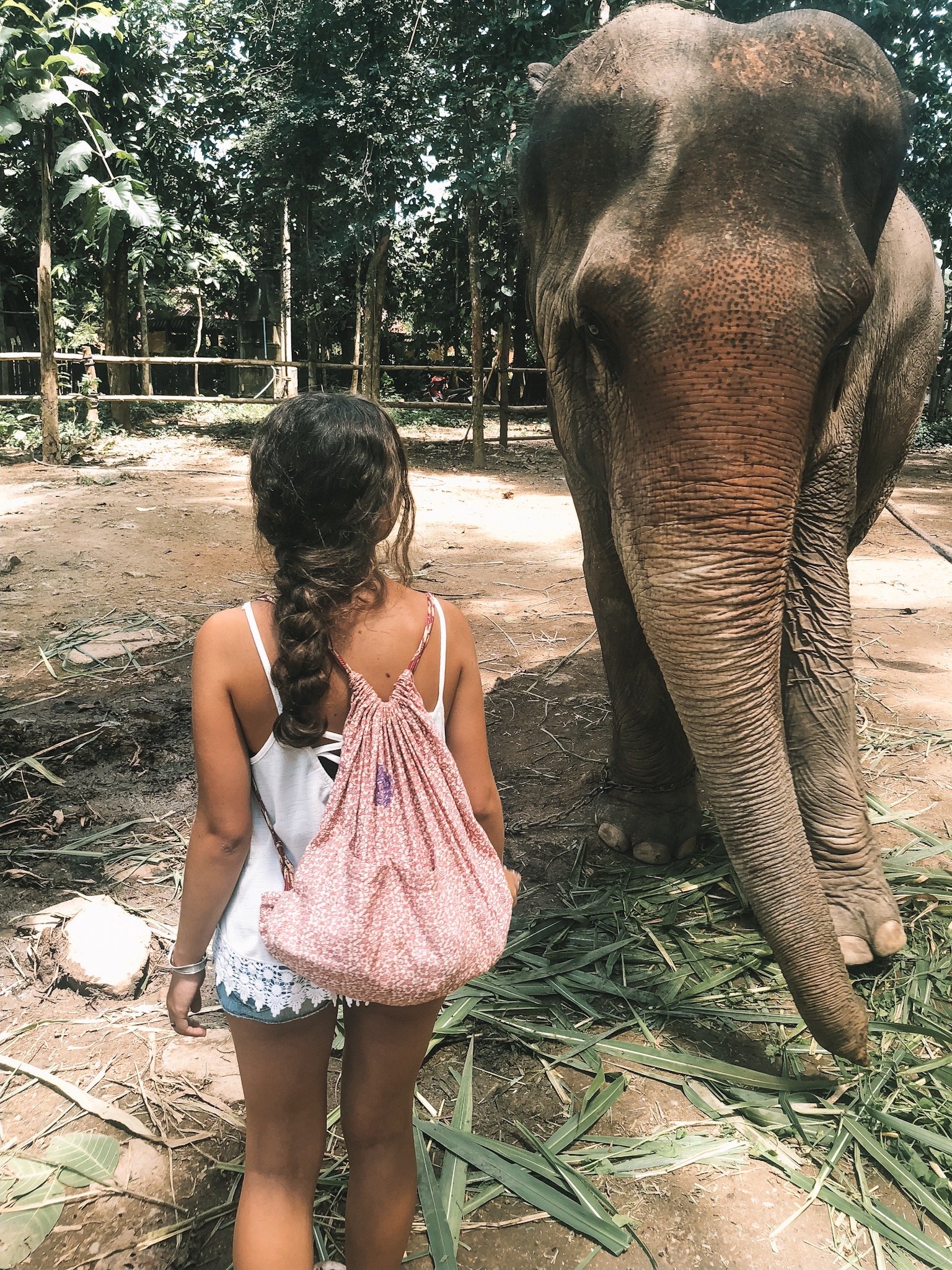Laos Weeks Six & Seven: Vientiane
Laos Weeks Six & Seven: Vientiane
When I started planning this trip, I found two organisations in Laos that do textile workshops and classes. I was very excited to go there, probably more than any other country. After six weeks, it was time for my friend to leave and I continued the trip alone.
First stop in Laos was Vientiane the capital. A small, walkable city, very different to other South East Asia capitals such as KL, Bangkok or Jakarta. Laid back people, very cheap food and coffee, sleepy tuk tuk drivers, temples, great textile shops and museums.
Most tourists visit for 3-4 days because there isn’t that much to do, however, I stayed for 11 nights because I did a three-day ikat weaving workshop and a six-day intense natural dyeing course. My only problem with Vientiane was accommodation. I went to Vientiane twice, because I wanted to do another weaving course and ended up returning in December. Both times the accommodation was terrible. I stayed in mid-range hotels and was very disappointed: dirty towels, weird odours, lots of noise and not the friendliest staff. Anyway, I was there for the courses and they were amazing.
Houey Hong Vocational Training Centre for Women is located in Houey Hong village, about 20mins from the centre of Vientiane via car. It is surrounded by a big garden with plants that can be used for natural dyeing. There is an office, a shop, two weaving rooms, a dyeing area, a small exhibition room with antique textiles and two sewing rooms. The founder, Chanthasone Inthavong wanted to provide training for various skill levels in weaving, natural dyeing and tailoring for women in rural areas who are disadvantaged, poor and/or have a disability. Their work supports Lao’s traditional crafts, keeping techniques alive.
The founder now lives in Japan, and her sister Sengmany manages the centre. I met both of these ladies while I was there. Sengmany is one of the sweetest people, coming to check up on me, translating my questions to my teachers and their answers to me, and making sure I understood everything. Another member of the team I really liked was Junko, a japanese lady that works in the school next door teaching art to children, but also works part time at the centre, usually doing the one day workshops with tourists.
Here are some photos of the antique collection they have at Houey Hong, everything is hand and naturally dyed, and handwoven. Some of these pieces are over 80 years old.
The first three days, I did the Ikat weaving workshop. Ikat is a dyeing technique used to pattern textiles. It’s a form of resist dyeing. In Ikat the resist is formed by knotting individual yarns or bundles of yarns in a designed pattern. Knotting tightly some parts of the yarn before dyeing it will keep the tied parts the original colour of the yarn while dyeing [and therefore changing the colour of] the rest.
Ikat Weaving Workshop:
First I had to measure the length of my beater on the loom — it was 35cm long. Then my teacher prepared this construction for me (see photo above), it’s 35cm measuring from the outer side of each of the two poles. Then I took my un-dyed silk skein and made a knot at the bottom left pole. I went around both poles twice before going about two fingers up, went round both poles twice on that level and then again two fingers up. As you can see I went up 13 times. When I reached that point I went back down again. I did it until I ran out of yarn. The silk yarn was about 150g.
The next step is to “copy” the pattern on the yarn and do the tying or knotting. The pattern consists of 13 lines, that is why I went around the poles 13 times.
After tying, we removed the skein from the poles and took it in the dyeing area. I chose to dye it with sticklac. Sticklac is a scarlet resinous secretion of lac insects. We had to crush the sticklac in very fine powder before mixing it with tamarind and making the dye. After dyeing and washing, we let it dry and then we spun the silk yarn — to be ready to be used as weft the next day.
The next day, I started weaving. We decided to add a bit of Chok weaving. Chok is a technique which you do with your fingers, using different colours, it creates a texture like embroidery. I learnt how to design a pattern and “save it” on the loom using this technique my last week in South East Asia.
After that, I started weaving. I first used some silk that was fully dyed with sticklac (no ikat pattern) for about 10cm. Then I started making the pattern. Each line would be repeated 4 times, so the whole pattern was made out of 52 lines. After each pattern I would do a bit of plain weave using the silk dyed with sticklac only. I found keeping my edges straight very difficult. However, according to everyone it’s just a matter of practice and now my edges are much better. Here are some photos of the work in progress and final piece:
Before I continue talking about the six day intensive natural dyeing course, I’m going to talk about some of my favourite places in Vientiane.
Restaurants:
ATMO - L’atmosphere: Quite posh, french-lao fusion. Very nice interior with nice atmosphere. The staff is the best!
Cafe Ango: Amazing Japanese restaurant. Recommended to me by Junko, my Japanese teacher. The food isn’t sushi, it’s “the way we eat food at home” (Junko). Very cheap.
Lao Kitchen: Traditional Lao food restaurant.Noy’s Fruit Heaven: Best smoothies and juices. They also have vegan food and traditional lao food.
Phakhao Lao Restaurant: Traditional Lao food.
Pimenton Restaurant: Steakhouse, quite expensive. Probably the best french fries I had in Asia.
Cafes:
30mL Espresso and Bar: Lots of breakfast options, nice juices and smoothies.
Le trio coffee: My favourite place in Vientiane! Really sweet staff, the best croissants I’ve had in my life and great coffee.
Little House Cafe: Owned by a Japanese couple, lots of nice teas and coffees, very nice and cosy interior. I also saw three ladies knitting here.
Once upon a time cafe: Nice all day cafe, good breakfasts, friendly staff and very nice interior.
Suzette: French crepe place, nice crepes and great coffee.
Shops:
CamaCrafts and Mulberries: These two shops are next to each other. Beautiful silk scarves and other products. Most of them naturally dyed.
Carol Cassidy Lao Textiles: Carol Cassidy’s designs are amazing. Modern designs and colour combinations but still they use traditional methods of production. You can also see the room where they store all their dyed silk yarn. Heaven.
Dee Traditional Antique Textiles: Amazing antique textiles. I wanted to buy the whole shop.
HerWorks: Here all products are produced by women from ethnic minorities. The labels say exactly who made the product and how. Mix of modern and traditional designs.
Interwoven: Really lovely jewellery made from artisans around Laos.
Kanchana Tha Beauty of Lao Silk: Naturally dyed traditional scarves and skirts. The owners own the Lao Textile Museum.
Saoban: Beautifully hand-crafted, eco-friendly products made in the villages of Laos. It is a social business that works with traditional artisans to preserve and promote Lao village crafts.
Other places to visit in Vientiane:
COPE visitor centre (Cooperative Orthotic & Prosthetic Enterprise): The main source of artificial limbs, walking aids and wheelchairs in Laos. At the visitor centre there are various informative exhibits about prosthetics and the unexploded ordnance (UXO) that unfortunately, make them necessary.
Ho Moune Thaentaeng Museum: Textile Museum, founded by Douangdeuane Bounyavong, a really sweet lady, which I met at Houey Hong. She is a writer and researcher and she’s written a book on Lao textiles and culture. It’s quite difficult to find this place so I recommend talking with Junko or Sengmany from Houey Hong and asking them to organise it for you.
Houey Hong Vocational Centre: One day (or more) weaving and dyeing classes, antique textiles and a great shop!
Lao Textile Museum: The first private museum in Laos. Antique pieces of silk made by different ethnic groups of the country are on display. The exhibition is displayed in a wooden house of typical Lao style, surrounded by peaceful gardens.
Morning market: Textiles, yarns, food, anything you want really.
Patuxay Monument: A war monument in the centre of Vientiane. The Patuxai was dedicated to those who fought in the struggle for independence from France.
Six Day Intensive Natural Dyeing Course:
My teacher’s name was Yo. He was really funny, and tried very hard to teach me everything he knows about dyeing and a bit of the Lao language too! I really enjoyed my classes with him.
First, we tie dyed a silk scarf. I wanted it to be dyed green, so we first put it in indigo (which makes blue) and then jackfruit (which makes yellow). I dipped it in indigo three times, because I wanted a really dark green. Then I took it out, washed it, and added it to the jackfruit dye. For the jackfruit we used the bark of the tree.
Jackfruit recipe
1 kg silk (or other dyestuff)
2kg jackfruit
50L water
50g limestone (similar to alum)
1 teaspoon salt
We added all the ingredients (except for the silk) in a big stainless steel bowl and put it on the fire. After it started boiling, we left it for 30 mins. Then we let it cool for a while before adding the silk scarf in. We “massaged” the folded silk scarf to make sure the dye goes everywhere, for 10 minutes. Then we took it out, washed it, and put it back in the dye again. We heated the dye until it was boiling, while stirring. After 5 minutes we took it out, washed it, removed the sticks/ropes that were tying the fabric and hang it out to dry.
(Fun fact their Indigo Vats are 22 years old!)
Ash water
Ash water is used a lot in Laos. They use it as mordant with some dyestuff, but they also use it to soften their silk and cotton. They collect the ash and then use a sieve to make sure only tiny pieces of ash are collected in a bucket. The bucket has some small holes underneath (around 10 holes which have a 2cm diameter each) Then the hang it from somewhere and put another bucket underneath it on the floor.
They add water in the bucket that is hanging and they leave it overnight. The next day they collect the ash water from the bucket on the floor. To make their skeins softer, they soak the silk and cotton for 20 mins in water. Then they take a big pot (30L) full of water and add approximately 2L of ash water. If you touch it, it must feel very oily. Then, you heat the pot, and bring it to boil. Then you add the skeins, and leave for 1 hour. You have to check and stir, making sure they don’t get tangled.
Mordants
Instead of alum they use limestone, which makes the colour brighter.
To make colours darker, they use iron and vinegar.
Iron/Vinegar Mixture:
500g of rusty nails / 1L of white vinegar / 1L of water
Then boil and stir until 2L become 1L. Then leave to cool. This can be used at any point.
Sticklac
Sticklac has to be crushed first, and then it must soak overnight. Sticklac makes pink and red.
For pink:
1kg silk
2kg lac
1kg tamarind
500gr limestone
30L water
Remove the lac dyestuff from the water, using a sieve and muslin cloth. Then add the tamarind in that water. You have to keep squeezing until all the juice from the tamarind has left, then remove the tamarind. Add skeins in the dye (after soaking them for 20 minutes in water) and add the limestone. Leave them for five minutes. Put the pot on the fire, wait for it to boil, and then let it simmer for one hour. Keep stirring. After an hour, remove skeins, wash and leave to dry.
For red:
1kg silk
5kg lac
2kg tamarind
1kg limestone
30L water
Remove the lac dyestuff from the water, using a sieve and muslin cloth. Then, you have to dye your yarn yellow (we used jackfruit). For the jackfruit dye we used a 1:1 ration (so 1kg silk, 1kg jackfruit). We left the skein in the jackfruit dye for one hour. Then we washed it and let it dry. While it was drying we prepared a limestone/water bucket (1kg silk: 1kg limestone, 24L water). We added the skein in the bucket and left it for 20 minutes. While the skein was in the limestone water bucket, we added tamarind to our dye, squeezing it so that all the juice comes out. We also added 1 cup of the limestone water mixture in the dye. Then we added the skein, left it in there for five minutes before putting it on the fire. After bringing to boil, we left it for one hour. Then we took it out, washed and left it to dry.
Except for Sticklac and Ebony, the rest of the plants we used to dye had similar recipes.
Onion Skins:
1kg silk:
2kg onion skins
50gr of limestone mixed with 24L of water (makes gold) or 30gr of iron and vinegar mixture (makes brown)
50L of water
We made both colours.
First you add all your dyestuff in a pot. You add half the amount of water you need. Bring to boil and then let it simmer for 30 minutes. At the same time put the silk to soak in water for 20 minutes. Then, using a sieve, remove the dye and put in a bowl. Put the onions back in the pot, add new water (the rest). Bring to boil, simmer for 30 minutes. Use the sieve to remove the onions. Put the two dyes together. Add your skeins of yarn in the dye. Bring to boil, simmer for 30 minutes. At the same time, prepare 2 buckets. One with iron and one with limestone. Take the skeins out, wash them, and put one in the limestone bucket and one in the iron bucket. Stir, and leave for 20 minutes. At the same time, take half of the dye out, and put it in another pot. Take the skeins out, and put one in each pot. Bring to boil, simmer for 30 minutes (or more if you want a stronger colour). Wash, and hang out to dry.
We used the same recipe for Mangosteen shell - eggshell colour (only with iron), Mahogany bark - light pink (only difference is we had to cut it in tiny pieces and let it soak overnight, and we added 1L of ash water as mordant), Bombay Black Wood - yellow (only used iron), Coconut shell - beige/grey (only used iron) and Mak Hon Mon fruit - brown (no mordant - has enough tannins).
Ebony:
The ebony found in the village produces grey whereas the ebony found in the forest produces brown. Ebony is like indigo, it works with oxidation.
1kg silk - 5kg ebony (fresh)
30L water
1L ash water
1L alum/limestone
1L mud
We soaked the ebony fruits overnight, with the ash water, mud and limestone. After soaking we removed the ebony fruits and kept the dye. We added the soaked skeins (which had been soaking for 20 minutes) in the dye (no heat yet) and left them inside for five minutes. Then we took them out, put the pot on fire, added the skeins, brought to boil and left them inside for one hour. If you want a really dark grey or black you have to take the skeins out every 30 minutes for about 5 minutes each time, to let them oxidise.
Usually for dried dyestuff we used double the amount of the skeins/fabrics. If the dyestuff is fresh then it’s five times the weight of the yarn/fabric. If it’s seeds (like Anato seeds) it’s half the amount of the skeins/fabrics.
i.e.:1kg silk - 2kg dried leaves/bark/flowers
1kg silk - 5kg fresh leaves/bark/flowers
1kg silk- 500gr seeds
This is a photo of everything I naturally dyed. Silk and cotton skeins. Natural dyes used: Indigo, Sticklac, Jackfruit (bark), Onion Skins, Mangosteen (shell), Mahogany (bark), Coconut (Shell), Bombay Black Wood (leaves), Ebony (fruit), Mak Hon Mon (fruit) and Anato (seeds).
I loved my 11 days here. I actually came back even though I wasn’t supposed to in the beginning of December. More about what I did then soon. Next blog post is about Luang Prabang, another city in Laos. There I did natural dyeing, weaving, batik and bamboo weaving.
Have a lovely weekend,
xxx Christiana
Indonesia Weeks Five & Six: Bali and Nusa Penida
Indonesia Weeks Five & Six: Bali and Nusa Penida
It was my second time visiting Indonesia. Last year in September 2017, I visited Jakarta, Bali, Lombok and the Gili islands. This time we only went to Bali and Nusa Penida.
Last year when I went to Bali, I stayed in Ubud. (I am planning to write a blog post about Jakarta, Ubud, Lombok and the Gilis after I finish these textile trip series.) This time round, we only stayed in Canggu, and went on a day trip to Nusa Penida. Canggu is quite different from Ubud. I like both for different reasons.
Canggu is a coastal ‘village’ on the south coast of Bali. It is 10km from Kuta. Canggu is the perfect place to relax, with beaches, cafes, restaurants, pools and bars. There are still scenic views of paddy fields and coconut groves, however Canggu is getting very popular and new villas, shops and cafes are being built everyday. What I liked about Canggu is that it’s a mixture of very friendly locals, tourists, as well as Europeans and Australians that have moved to Bali and work from there. Canggu is full of digital nomads who work from amazing co-working spaces, like Dojo Bali. There is a sense of community and I really felt that when I was there.
We stayed in a great AirBnB, in Canggu, close to Echo Beach. The area is great to relax, with lots of amazing food and cafes! We stayed there for nine days - we both had some work to do while we were there so we worked from cafes and co-working spaces, with breaks for a swim in the sea, or a snack.
Some photos of the shared pool at the AirBnB:
One of the things I loved the most was that every day we went to watch the sunset on the beach. This is something most people that live in Canggu do on a daily basis. Around 17.30 everyone stops working and goes to Echo beach, to have a drink and enjoy the beautiful sunset. Here are some photos:
There are amazing shops in Canggu, with great clothes, accessories and homeware. I was very inspired while I was there, and I think these few days made me want to focus more on interiors instead of fashion. Seeing great interiors in airbnbs, cafes, restaurants and shops everyday made me want to start creating. I only did one workshop while in Bali, a day of macrame, which I talk about further down. I really missed doing workshops while in Bali, however it was nice to relax and think about what I want to do when this trip ends. Looking back, it definitely was the time I fully relaxed and started thinking about the future.
Here are some photos of the amazing interiors:
Here is a list of my favourite shops in Canggu:
Cove Island Essentials: Clothes, bags, shoes, rugs, vases and jewellery. Beautifully selected items.
Crate Concept shop: Next to the Crate cafe, very stylish clothes from Balinese and some international brands. Both women and menswear.
Frockk Canggu: Nice selection of women and menswear.
Lucy’s Batik: Very close to Seminyak, original batiks made in Indonesia. Homeware: carpets, duvets, placemats, pillows as well as some clothes and children toys.
Quince Cafe Shop: Textiles for your house, ceramics, wooden spoons, prints. I wanted to buy everything in this shop. Plus it’s in one of my favourite cafes of Bali, with the friendliest owner and delicious food. Definitely recommend.
Yoli and Otis: Australian brand with beautiful clothes. All naturally dyed. Their clothes are for children and women.
Here is a list of all the places we went for food (breakfast, lunch, dinner):
Balibola Cafe: This cafe is quite new, the decor is very playful and we really enjoyed working from here, meeting the owner and having a friendly chat, and of course the delicious food.
Copenhagen Cafe: I loved this place, you choose many small plates and try different flavours. It’s small but cute and the all-day breakfast is delicious.
Crate Cafe: Another nice place to sit and relax, work on your laptop and have salads, food, snacks and of course smoothies. There’s also a gallery at the back and a concept store right next door.
Give Cafe: If you want to have some food and also make a difference this is the place to do it. Here every purchase has a purpose. It’s a 100% plant based cafe that gives 100% of its profit to the people and the places that need it. They have chosen three charities one that helps animals, one that helps the planet and one that helps people. Once you pay for your food, you get a token - and you choose which charity you want to help and put the token in one of the three boxes.
Holiday Cafe: One more place I loved, with great decor and a space that hosts exhibitions (when we went there was a photography exhibition on corals). Macrame wall hangings and baskets decorate the walls, and the textiles are all beautiful. The food was once again amazing.
Kynd Community Cafe: Another plant-based cafe with great all-day breakfast and coffee. We tried both savoury and sweet breakfasts and liked them both.
La Baracca: Teleport to Italy for a few hours and have great pizza, pasta and wine.
La Brisa Beach-Front Bar: Another place we really liked. It has jungle/pirate feels, a big pool, a great sunset view, nice food and cocktails.
La Laguna: My favourite beach-front bar. A gypsy wonderland with hand-painted caravans and they even do gypsy readings! On Tuesdays they have movie nights. They also do a gypsy market every month with local handcrafts.
Mad Pops Bali: Vegan Ice Cream and cocktail flavoured ice lollies — what more can I say. We went there a few times as well.
Nude: Really good coffee, nice interior and once again the classic (and great) organic food.
Peloton Supershop: Vegan all-day cafe. Smoothie bowls, smoothies, pancakes, salads, cocktails. Everything you can imagine — you can find it here. I am not vegan but I loved everything I tried there.
Quince Cafe: Probably my favourite, the food is perfect, the owner is really friendly and I really liked the decor and shop.
Santorini Greek Restaurant: My friend probably loves greek food more than I do, so we ended up going there a few times. The owners are Greek, and it was nice talking in Greek with them and sharing stories. The food was traditional and really good.
The Lawn Beach Lounge: Another perfect place for sunset, drinks and food. There is also a pool and they host a lot of parties and events.
The food in Canggu is great guys. The vegetables and fruit are amazing. I probably had around three smoothies a day while I was here.
Macrame workshop with Nadjma Achmad (@najmasmeer):
I did a basic Macrame workshop with Nadjma. Macrame is a textile technique which involves knotting. It looks a bit like lace or a webbing. Knot combinations create intricate patterns. Usually rope or cotton string are used to do this. Macrame is getting quite popular and lots of people use them as wall decorations and hangings. However, you can also make baskets, garments, bags, jewellery and even hammocks! According to Nadjma, macrame was used by sailors — they used different knots to decorate knife handles, parts of ships or bottles.
First, I learnt the basic knot which is the square knot. Using this knot I created diamond and V shapes. We worked together, hanging a piece of wood on the wall and working while standing. Nadjma would show me a knot on her piece and then I would do it on mine. It was a fun lesson and it was nice working together. I made two small wall hangings, one necklace and one plant hanger. It’s a really easy technique and it goes very fast unlike weaving or hand-knitting.
On the weekend my friend and I decided to go on two day trips - one to the Green School which is between Canggu and Ubud, and one to Nusa Penida.
Green School Bali is a non-profit, private and international school located along the Ayung river, near Ubud. The school was founded by John and Cynthia Hardy. The school opened in 2008 with 90 students and now has approximately 450 students. The school is in the jungle. It has been built with ecology and sustainability in mind. They use renewable energy resources such as micro-hydro power and solar power.
You can go visit any day, and there is an english guided tour where the guide (staff and volunteering teachers) shows you around and talks to you about the history of the school and the beliefs and aims of the founders. We were amazed by what they created. It’s like a dream school. The students cultivate an organic garden as one of their learning activities. Their lunch consists of the vegetables and fruits they’ve planted, helped grow and harvested. The food is cooked with sawdust fuel from a local bamboo farm. It is served on ingka - straw baskets with a compostable banana-leaf lining. (No dishes to be washed!)
The buildings are built from bamboo and some of them are high up like treehouses! Shoes are optional, and students learn to build bridges and bamboo bikes. There is a menagerie of rabbits, pigs and chickens — again the children are the ones that take care of them. Apparently, the students’ favourite place is the mud pit which is for mepantigan — a balinese martial art.
The vision of the school is to educate ‘young green leaders’. The school consists of pre-school, primary school, middle school and high school. What we liked was that except from maths, literature or history - which are taught here too - children here learn more about teamwork, problem-solving (in real life situations) as well as about the environment. It is a school that prepares students for university but also equips them with survival skills.
What I kept thinking while I was there was ‘this is a school where I’d be so happy to go every day - I’d never pretend to be sick or wake up dreading to go’… It’s like a fairytale but at the same time so progressive. It is a place I’d really like my children to maybe go one day.
Nusa Penida:
After snorkelling in Thailand, we really wanted to snorkel again. Therefore, we decided to go on a day trip there. First of all let me just say that you should never EVER book a tour from the little kiosk that offers day tours next to Echo Beach. We paid exactly double what everyone else paid on this tour. For no reason! We should have booked online or just arranged a transfer to the island and then found a snorkelling company there. We got really ripped-off but I guess it had to happen at some point.
We woke up at 6 because the driver was supposed to pick us up between 6.15 and 7.15 (we got picked up at 7.30). We reached the port, and after waiting for another hour we went on a boat that took us to Nusa Penida. There we found our snorkelling “guides” who couldn’t speak any English. I got stung by something (probably a jellyfish) and when I asked what it was and if they had something for me to put on they just said “don’t know” or “no english” and one of them even laughed.
Anyway… we enjoyed snorkelling here as well, we saw beautiful fish and corals. We went to Crystal Bay and Manta Bay, however we didn’t say any Manta Rays. After around three hours we got back to the port — where we were told that the snorkelling tour had finished. However, no boat was taking us back to Bali for another four hours. That’s when we also found out that everyone else on the tour had paid half of what we paid. After realising how angry and disappointed we were, the snorkelling tour guides gave us a scooter for free to go around the island. We went to Atuh beach and Crystal bay and did some hiking as well. We returned to the port the time we were supposed to, but the boat was delayed. We were supposed to be back in Bali at 17.30 but we returned at 21.00, we were really tired and quite angry… Anyway, it was the only ‘bad’ experience we had so far, and it wasn’t all bad so we focused on the good and went for food and wine and got over it. I would like to visit Nusa Penida again, there are many nice places we didn’t have time to see.
Some places I’d like to visit next time I’m in Nusa Penida:
Pura Goa Giri Putri Cave
Kelingking Secret Point Beach
Broken Beach
Thousand Island (Pulau Seribu) Viewpoint
Tembeling Beach, Natural Pool and Forest
Gamat Bay (for snorkelling)
Despite that day trip, I loved being in Canggu. I loved the organic cafes, the food, the smoothies and the way of life. The weather, the sunsets and being able to swim whenever you want. I would really like to go back and live there for longer.
Next blog post will be about Vientiane, Laos. There, I did an Ikat weaving workshop and a natural dyeing one as well. They were probably my two favourite workshops I did while in Asia. More about them, next week.
Have a lovely weekend,
xx Christiana
Malaysia Week Five: Kuala Lumpur
Malaysia Week Five: Kuala Lumpur
Kuala Lumpur was one more place I was not supposed to visit yet somehow ended up in.
Flying to Bali we stayed in Kuala Lumpur for two days. Flights to and from there are cheaper, and since we had a stop over and were going to fly from there, we decided to explore this city as well.
Again, we stayed in an AirBnB. We paid around 20US dollars for a night. The room was in a nice central area, and we had a view of the Pagoda Towers. It was really big, very clean and with a shared outdoor terrace pool (overlooking the towers). There was also a restaurant/bar on the top floor. We went there for drinks while we stayed in KL.
I didn’t expect much from KL, I thought it would just be another big, busy city with lots of traffic and noise. However, I was pleasantly surprised. There wasn’t much traffic at all. Comparing to Bangkok the city was cleaner and more organised. People were not rushing and there were huge parks that looked like jungles in many places around the city, where people relaxed. It was a mix of skyscrapers, amazing architecture, tiny colourful streets, food stalls and Banyan trees. It’s one more place I’d like to visit again, for a longer time. I think there are many nice places to explore.
We were in KL only for one full day. My friend had work to catch up on, and I had a lot of things to plan and book for the following weeks. So we spent half of that day in a cafe called ‘Common Man Coffee Roasters’, they have a great menu with lots of breakfast and lunch options. The staff was very friendly, the wifi, coffee and music were all great.
Here is a list of places I visited:
APW Bangsar: Once a family-run printing factory. Now it has been transformed into a hangout area, event venue with some eateries. Amazing place!
Brickfields: (also known as Little India). Consists of textile and jewellery shops, spice and grocery stores, flowers everywhere and of course amazing food. I didn’t make a note of the Indian restaurant we went to however I recommend you visit this area and try some of the local Indian delicacies!
Central Market: Traditional art shops that sell batiks, wood carvings and other handicrafts.
KL Forest Eco Park: I couldn’t believe my eyes when I walked here — it’s a protected jungle the middle of the city. You can walk along canopy trails and bridges and for a minute forget that you are in a big busy city.
Petaling Street: If you want to buy souvenirs this is the place to go. There is also a great food market here.
Sri Mahamariamman Temple: a Hindu sacred place. I loved the colourful details as well as all the mosaics and carvings on ceilings and pillars. Definitely a must visit.
List of places I want to visit next time:
Islamic Arts Museum Malaysia: The largest Muslim Art Museum in South East Asia. Artefacts from all over the world. Prints, handicrafts and architecture. Unfortunately, we didn’t have time to visit this museum.
Lake Gardens: Another chance to forget where you are, offering many parks and gardens to explore such as a Butterfly Park, Bird Park and an Orchid Garden.
MyBatik KL: Unfortunately, I found this place after I’d left from Kuala Lumpur. They offer traditional batik classes and workshops.
National Visual Arts Gallery: The work displayed here is mostly from local artists but there are also some foreign artists. The work ranges from traditional skilled crafts like batik to modern artworks. The building is modern, and has a pyramid like shape, the interior is said to be inspired by the Guggenheim.
Orang Asli Crafts Museum: A little museum about the history and art of the original settlers of Peninsular Malaysia: the indigenous and aborigine tribes. Traditional handicrafts — carvings, tools, fabrics. Next to the National Museum which we also didn’t have time to visit.
Thean Hou Temple: One of the oldest and biggest Buddhist temples in SE Asia (1894). It’s on top of a hill and offers a spectacular view of the city. On the courtyard there are thousands of red lanterns.
Zhongshan Building: This 1950s building has been refurbished, and is now an independent arts hub. It is home to local artists and makers. The space has a gallery, print studio, a cafe (which also is a bar in the evenings), a record store as well as a bookshop and clothing shop. Again, I found this place too late and we didn’t have time to go.
Except from wanting to see another country, explore a new culture, try different food and see some of the attractions Kuala Lumpur is known for - the main reason why I wanted to go was because of their National Textile Museum.
I spent around three hours in there, taking everything in. It was amazing how I wasn’t planning to come to Malaysia, but a short visit helped me discover how many textile techniques they have there! Natural dyeing, batiking, weaving, tie dye, beading, embroidery, block printing, screen-printing and an amazing way of connecting two or more of these techniques, creating a beautiful texture.
I must say though, I was so disappointed when I entered the first gallery on the ground floor and 90% of the lights were not working. When I asked the lady at the reception if she could turn the lights on she told me they are ‘under maintenance’. It was so bad in some rooms, that my friend had to use the torch of his phone to help me see the details of some of the fabrics or read some of the labels… It’s so unfortunate that this is the case in this museum, the fabrics displayed are pieces of art and they get lost because of the poor maintenance.
The first gallery showcases the tools, materials and traditional techniques of textile making through the processes of weaving, embroidering, knitting and beading.
One of my favourite techniques that they use is called Tritik (which means stitching) it is a kind of resist technique. It produces small dots running around a single line. They do this on silk, thin cotton and chiffon. They first draw on the fabric, and then sew with a strong thread on the lined motifs. They then pull the end of the thread and tie it off. The folds create a resist. They then put it in a dye, rinse it and then remove the knots carefully revealing the pattern. For weaving they use back-strap looms and they also do the ikat technique, which they call Pua Kumbu.
They also tie dye and batik. Unlike Indonesia, where the artist holds the fabric on their hand and works on a specific part of the fabric, in Malaysia they stretch the whole fabric using a frame in order to batik. They also don’t dip the batik piece in many colours but rather paint specific areas with a paintbrush (there is no layering of colours).
Here are some photos:
The two following galleries exhibit selected heritage collections. There are lots of batik pieces. In the beginning all batik patterns were drawn by hand, however after a few years they also started using metal blocks of copper or brass. That way the artists were able to achieve very fine design patterns. The complex designs found in the ikat pieces were normally inspired by dreams, nature as well as beliefs and values. Decoration was very important for Malaysian people. The different decorations, the place they were on an outfit, the choice of colours — they all gave an identity to each community.
The final gallery showcases jewellery and personal items of the various ethnic groups. Accessories for Malaysian people are among the most important elements of dressing, whether to enhance beauty, for social status or as a religious requirement. Valuables and accessories became treasures and heirlooms, they were passed down to each generation in all ethnic communities.
The National Textile Museum’s collection is remarkable. It really reflects the rich and diverse types of textiles that can be found in Malaysia. It was a great experience to be able to see the traditional handiwork of the multi-ethnic societies of Malay, Chinese and Indian people. I never expected to see textiles that have been created with a combination of so many techniques. It is an incredible heritage, and I really hope that the state of the museum (no lights, dust, etc) changes to the better soon.
After this very short trip, and especially after visiting this museum I really want to come back to Malaysia, to spend more time in Kuala Lumpur but also travel around the country and try find places to learn some of these amazing techniques people used to create and decorate textiles.
I hope you enjoyed this weeks post, next one will be about Bali and Nusa Penida!
Have a lovely weekend,
xx Christiana
Cambodia Week Four: Siem Reap
Cambodia Week Four: Siem Reap
Last year when I started planning my trip I was thinking of only going to Thailand, Laos and Vietnam. However, this changed — I ended up going to seven countries instead of just three.
When my friend told me he was going to join me for the first month in Asia he said he really wanted to go to Cambodia. We decided to go for a few days and I am really glad we did. I wish I had stayed for a longer time and travelled to more places instead of only going to Siem Reap, but I am sure I will visit Cambodia again in the future.
I’d heard mixed things about Cambodia, people told me it’s dangerous while other people told me that it’s the opposite. I actually never felt uncomfortable or unsafe while I was there. People were helpful, kind and friendly.
On the flight from Bangkok to Siem Reap, I met Tann - a lovely girl around my age that is from Siem Reap but lives and studies in Phnom Penh. She was doing an internship at the children’s hospital in Siem Reap for a few weeks and that is why she was there. We talked on the plane and exchanged phone numbers and actually met my second day in Siem Reap. She came to my hotel, gave me a ride on her scooter, showed me temples, took me to secret spots, we saw the sunset and we also went for dinner. She was lovely and definitely one of the nicest people I met on this trip. She talked to me a lot about the country and it’s people, about traditions and the way of life.
Here are some photos from that afternoon:
When we decided to go to Cambodia I tried to find some textile workshops or a class. I came across Artisans Angkor. In 1992 it was a vocational school providing training to young Cambodian people (18-25 years old) living in rural villages of the Siem Reap Province. In the beginning, training was focused on the building sector. Later this changed — the focus was on the Arts and Crafts sector, in order to revive the Khmer cultural heritage while helping rural people find work near their home village. In 1998, ‘Artisans Angkor’ was founded as a workplace for young people trained in handicrafts by the vocational school.
Since it’s creation at the end of the 90s, Artisans Angkor has provided professional skills to communities with limited educational opportunities and has offered good working conditions and social advantages to it’s employees. It provided employment to over 1100 people, with more than 800 of them being artisans. While visiting you can see all these different crafts: silk weaving, stone and wood carving, lacquerware, silver and copper plating as well as silk painting. In 2003, with support of the French Agency for Development, Artisans Angkor became an autonomous and semi-public Cambodian company. The profits of the company are reinvested in the new training programs or construction of new workplaces in the Siem Reap province.
Here are some photos from the different workshops:
Their website looked really professional and reading online about them, I really wanted to go visit and see all this in person. I also read that I could do two textile workshops, traditional weaving and silk painting. So I booked both of these while I was in Thailand. No one got back to me with a confirmation, and I had to send a lot of emails before someone did. Unfortunately, the workshops were very disappointing. They were both only three hours long, with no lunch or even water provided… And they cost 50 US dollars each. Comparing to the weaving workshops I did in Thailand before coming here, and all the other workshops I did after Cambodia —definitely, not worth it.
The first day, I did the weaving workshop. They took me to their silk farm, which was nice because you could see the whole silk process. When we got to the dyeing area, I was disappointed… They had a huge board talking about natural dyes and showing examples of the plants, and then they told me I will do some dyeing — and the dye was chemical. They don’t do any natural dyeing anymore. Which I understand, and that’s fine — however, when they do the tours, if someone doesn’t know about textiles and sees the board and doesn’t ask they don’t know that they use chemical dyes… They don’t make it clear, and I think they are trying to show that they use natural dyes even though they don’t. When I visited the shop (which is huge) there wasn’t any naturally dyed fabric. Everything was dyed with chemical dyes. Which is a shame, because if you are reviving traditional techniques then you definitely should revive that one since it’s so much better for us (wearers) and the environment. The workshop was basically a tour of the silk farm — with almost no weaving. When we got to the looms, I was shown how to weave (plain weave), which I knew, and they didn’t let me weave for more than half an hour. I was very disappointed, but I guess I should have asked for more details before booking and paying for the course.
Here are some photos from the weaving workshop and silk farm:
The next day I had the silk painting workshop. I was quite disappointed with that as well. I expected to be painting with dyes on a free piece of silk, however I was basically painting on a piece of silk which was on a frame like a canvas. They gave me three traditional patterns to choose from (elephants, a bird or a lotus), I chose the lotus. I was painting with acrylic paint inside the lines, that were already there (like a colouring book!). I felt like I was back in nursery. I don’t even have a photo of what I did, I really didn’t like it… Oh well - it taught me a lesson, never book anything without reading exactly what it is, how long it takes and reviews!
As you can probably see, I had mixed feelings about this place… I’d say it’s very touristy, tons of people visit everyday, and I felt like it’s more of an attraction rather than a place to go learn authentic techniques and crafts.
The next day I visited an amazing place that I found by chance! It is called IKTT (Institute for Khmer Traditional Textiles). I was walking down a street when suddenly I saw women of all ages weaving, spinning, tying (for ikat) and winding yarn. I immediately walked in and a very nice lady came up to me and told me the story of the institute. She was Japanese, and had moved to Siem Reap because of her fascination with Cambodian silk weaving. She introduced me to all the women and explained the ikat technique, she let me spin and wind some silk and talked to me about dyeing.
The IKKT specialises in the revival of the Cambodian Silk Ikat. In 1996 bu Kikuo Morimoto founded this institute. He was Japanese, and in 1995 he took a trip to Cambodia and was really sad to see that only a few old women in villages knew how to weave. He really wanted the skills to pass onto the next generation. As she explained to me, in 1995 the silk production situation was bad. Weaving was still happening in rural villages however the quality was poor. People were using synthetic fibers and chemical dyes after WW2. Apparently in the few places where women were still weaving, people (with a higher status) would exploit them, by giving them a very poor pay. It was getting to the point where it was no longer beneficial for the family to pass down the skills and therefore many weavers stopped weaving. Morimoto, started producing silk in order to start the revival process. Once there was silk, it was possible to start giving opportunities to skilled weavers by setting up workshops for the young weavers of villages.
In 2002, Morimoto took the institute to the next level. He started ‘Project Wisdom’. He bought a 5 hectare plot which is 15km north of Bayon at the centre of Angkor Thom. He started recreating a ‘traditional’ forest with all the plants required to breed silk and dye beautiful natural colour. The farm/forest in the outskirts of Siem Reap that you can visit (unfortunately, I couldn’t because I didn’t have enough time) where you can see all the natural dye plants as well as the silk farm. They use almond leaves, indigo, banana leaves, bougainvillea leaves, coconut bark, lychee wood and sticklac to dye their silk before weaving with it — reproducing traditional textiles.
It’s a really fantastic place, with wonderful people and amazing textiles. The founder Kikuo Morimoto passed away last year, but his work lives on. He was a great man, with a lot of knowledge about textiles and sustainability, with great ideas about the connecting the past with the future. If you’d like to read more about him you can here. I really recommend visiting this place. I was the only tourist there and they explained everything to me in great detail. They also offer indigo and shibori workshops at their forest. To book you have to go to the shop first and book for the following day. Even though I wanted to go to the forest/farm, I didn’t have enough time and I also had already done quite a lot of shibori so I chose not to prioritise this workshop. However, if I go to Cambodia again I would definitely visit them again. Here are some photos:
The lady that showed me around IKTT told me about a museum I did not know about. The MGC Asian Traditional Textiles Museum. It contains textiles from Cambodia, India, Laos, Myanmar, Thailand and Vietnam. The museum gives an overview of textile patterns and adaptation of the Mekong and the Ganga region. Raw materials are displayed as well as the process of spinning, winding, dyeing, weaving and embroidering. The museum is quite big but again I was the only one there. The lady at the entrance came with me, talking to me about the different textiles of each country, answering questions I had and explaining things that were not translated. Unfortunately, I wasn’t allowed to take any photos inside. However, it was nice to see textiles from India as well, since it’s the only country I knew I wouldn’t visit in this trip (yes it’s on my list - I’m hopefully going in 2019). I really recommend visiting this museum if you are in Siem Reap - except for textiles you also learn a lot about Buddhism, the history of the different countries as well as myths and legends. One of the things I didn’t know and really liked was that according to the Cambodian Royal Protocol, each day of the week corresponds to a colour.
Red for Sunday
Orange for Monday
Purple for Tuesday
Mustard - Green for Wednesday
Green for Thursday
Blue for Friday
Burgundy for Sunday
During royal ceremonies, people from the Royal family and their guests were all required to wear clothes (Sampot and Chorebap) of the ‘colour of the day’.
Except from these places some other recommendations (Siem Reap Centre) I have are:
Angkor National Museum - Museum about the Khmer history
Blue Pumpkin - Cafe at Artisans Angkor (snacks and lunch)
Cuisine Wat Damnak - Traditional Khmer food
Gelato lab - Best ice cream!
Malis Restaurant Siem Reap - Traditional Khmer food
Mekong Quilts - Beautiful textiles
Night Market Pub Street - Food and food and more food
Vibe Cafe - Vegan, great atmosphere, amazing food
We spent the next few days closer to the Angkor Wat ruins. We treated ourselves and stayed in an amazing hotel: Anjali by Syphon, that we loved. The food there was amazing, and there is also a pool and a spa! The hotel arranged a tuk tuk to take us around all the different temples in a day and we really recommend you do the same. The driver will take you to all the temples he recommends as well as temples you want to see, he will wait for you, will offer you water and even umbrellas for the sun. It gets really hot during the day — so start early.
Most of all we liked the Bayon, a state temple of Jayabarman VII. There are 54 Gothic towers decorated with 216 smiling faces. It is known as the ‘face temple’ and was mesmerising. Angkor Wat was of course amazing as well, its really big, there are many spaces to see and explore. I would really recommend you go everywhere, wait in line to go up some stairs, try and go to all the separate rooms and in general just explore. We only had one day to explore the temples but I think the 3 day pass is worth it and probably better as well since it gets so hot during the day and doing everything at one go is very difficult. Ta Prohm was another favourite, also called the ‘Tomb Raider Temple’ because of the Lara Croft movie featuring Angelina Jolie. Crumbling towers, ruins, and trees, roots and moss everywhere. It’s one of the most atmospheric places I saw in Asia. It feels untouched, and like nature and the jungle is taking over the temple. We also really liked Preah Khan.
Here are some photos:
I loved everything about Cambodia. It’s nature, it’s really bad roads, it’s food, it’s people and as always the textiles and temples. I really want to explore more parts of Cambodia and here is what’s on my list:
Phnom Penh - there is a silk island called Koh Dach in the city, museums, pagodas
Southern Islands - Koh Rong etc. (AMAZING beaches)
Kratie - dolphins at the Mekong, nature, peace and quiet
Kampot - seaside towns, countryside, trekking, caves
Mondulkiri - trekking, nature, waterfalls, elephants
Hope you enjoyed reading about my short trip to Cambodia and that you all had an amazing Christmas! Next week will be about my (really short) trip to Malaysia.
Lots of love,
Christiana
Thailand Week Three: Bangkok and Phuket
Thailand Week Three: Bangkok and Phuket
From calm and peaceful Chiang Mai — we went to crazy Bangkok. Big change. So many people - so much traffic. I must admit I have a love - hate relationship with Bangkok.
We stayed in Ari (also spelt Aree) which is located in the north of Bangkok. My friend booked an Airbnb for us and I didn’t know where it was until I got there. In the beginning, I was a bit disappointed, all the places I had found that seemed interesting and I wanted to visit (museums, shops, restaurants, temples) were far away, and I hadn’t found anything in Ari… However, after two days I started really liking Ari - it’s an up-and-coming neighbourhood with great cafes and restaurants, its quieter than the rest of Bangkok and has great transportation links (Sukhumvit Line of the BTS Skytrain). There aren’t many tourists here, mostly locals and foreigners that live and work in Bangkok.
Some places I suggest checking out if in the Ari area:
La Villa Ari - An open air community mall next to the BTS Ari station. Many cafes, restaurants and independent shops. Lots of people come here to relax and socialise.
Aree Garden - Boutique shops, more cafes and restaurants and an outdoor market as well, they also do workshops and have fun events on the weekends.
NumThong Gallery - Small and cute art gallery, with exhibitions of Thai and sometimes International artists.
Cafes:
Common Room x Ari: Tiny, but nice coffee and breakfast and very friendly staff.
Landhaus Bakery: OH MY GOD. Best pastries, cosy interior, great breakfasts, good wifi and good coffee. We loved this place and can’t recommend it enough.
Porcupine Cafe: Another favourite. Great coffee and snacks, nice interior. Perfect for working or relaxing with a good book.
Puritan: We didn’t go there, but it was recommended to us by some friends that live here. Apparently the desserts are great and the decor is a mix up of different styles and apparently a must see!
Restaurants:
Joha: Amazing Korean food, we went here twice because we couldn’t choose from the menu and wanted to try as much as possible!
Lay Lao: Traditional Thai food, cosy interior.
Salt: One of my favourites! Mix of Japanese and Italian cuisine, great atmosphere both inside and outside. Best cocktails, and really good desserts.
Street Food Soi Ari: Fresh Thai food, very cheap — many people buy their lunch from here and then go back to their office.
I’m not going to lie, I hated Bangkok the first day I was there. I decided to do all the touristy things and go to Wat Phra and the Grand Palace. It took me an hour and a half with a taxi to get there from where we were staying (this was back in my ‘I’m scared to go on a Grab motorbike that a stranger is driving’ days and for some reason I didn’t think of taking the BTS). I arrived and there were SO. MANY. PEOPLE. — tour groups, people shouting and pushing and bumping into you, no sense of personal space — really not what I wanted, and a big shock after being in Chiang Mai for two weeks.
I tried to get in and they stopped me because I was not wearing a t-shirt. I was wearing a tank top and had a shawl around my shoulders - but apparently that’s not good enough. They obviously had a shop that you could buy t-shirts from, and one ‘I love Thailand’ t-shirt was 400baht … When I went to buy a ticket, I asked if I can pay with card, and they told me no because I was only one person. Apparently, if you are with someone then you can pay with card, but not if you are alone... (I didn’t like that - there are so many solo travellers in Thailand and this is one of the most touristy places in Bangkok - I don’t understand why they do this) Staff was really rude and not helpful and I was really annoyed by the time I went inside. Once inside, even though it was beautiful - it was quite overwhelming because of all the people. I really recommend going as early as possible. I didn’t really enjoy my time there because of how packed it was. Here are some photos though - a lot of pattern inspiration and lovely colours.
There is also Queen Sirikit Museum of Textiles in this complex, however photos were not allowed inside. It was interesting to see how the Queen’s style changed. Early on, she only used fabrics and designs made in France. Very chic and European. However, after some time she changed her style. After visiting the North of Thailand, and seeing how women created textiles, their dyeing, the Ikat weaving, the traditional patterns and symbols — she started buying fabrics off them, to help them and to show them how important textile heritage is. The textiles would be sent to France, where famous French fashion designers would create her ensembles using the Thai textiles. The results were actually beautiful, a mix of East and West. It’s worth having a look, if you are already at the Grand Palace.
I spent the next day going to museums and walking around different areas. First, I went to the Bangkok Art and Culture Centre. There are some exhibits outside of the centre, and once inside there are lots of small exhibitions, shops and once again - cafes!
I actually found a shop in the Centre that was full of natural dyed clothes and accessories (unfortunately I didn’t take down the name of the shop, but it was next to a cycling shop). Here are some of the Thai brands that I really liked and found in the shop:
Homrak - Indigo tie-dyed accessories and clothes
Cubism - Naturally dyed linen clothes
For the past three years, at the BACC, there has been a project to develop handicrafts. The project involves educational activities and an exchange of knowledge between the networks of regional craft masters and artists/creators. This year it was based on basketry, and a lot of Thai artists / craftsmen went to Taiwan, Philippines and many places in Thailand, in order to learn and exchange a variety of new basketry skills. After their trip the artists created modern basketry that was displayed at the BACC, at an exhibition called ‘Revival of the Forgotten Heritage’. The items exhibited were created because of this exchange of knowledge and skills - the items were very modern, innovative and beautiful. A modern twist to traditional techniques and practices.
The other exhibition that was on was called ‘Subconscious’. It was an exhibition organised by female artists from three southern border provinces. They collaborated together with the aim of showing the way of life of people in their local area. ‘The exhibition is conducted by using the artist’s subconscious state to simulate imaginative paintings through creative works’. My favourite was Nordiana Beehing’s work. She presented the way of life through spaces and architectural forms using embroidery and different fabrics to do so. Her aim — to record the life story of the local people, but also to show how architecture is changing. As she says ‘In the past, the primary materials for construction used to be wood, but now the development of architectural forms are a mix of eastern and western influences. Thus, the value and importance of traditional architecture has begun to decline.’ I loved the subtle colour palette, the transparencies and layering of the fabrics as well as all the detail and time spent on embroidering.
Another artist that used textiles for this exhibition was Kameelah I-lala. Her work was about marriage, weddings and how women from her province desire and seek ‘the happiness, goodness, and the beauty of marriage life to compliment each other.’ Her work is mixed media, parts of wedding dresses as well as painting and embroidery are combined to create abstract pieces.
Next stop was Jim Thompson’s House & Museum.
Jim Thompson was an American born in 1906. Before WW2 he was an architect, during the war he volunteered for service in the US Army and was sent from Europe to Asia. After leaving the service, he decided to return to Bangkok and live there permanently. The hand-weaving of silk captured Jim Thompson’s attention and he devoted himself to reviving the craft. He contributed substantially to the industry’s growth and to the worldwide recognition of Thai silk. There are now Jim Thompson shops, that stock hand-woven silk products and fabrics, all over the world.
He gained further recognition through the construction of his house, by combining six teak buildings, which represented the best in traditional Thai architecture. Most of the houses were at least two centuries old. They were from the old capital, Ayudhya and were dismantled and rearranged in Bangkok. On the 26th of 1967, he disappeared while on a visit to the Cameron Highlands in Malaysia. It’s still not known what happened to him even though there are a lot of rumours and stories.
When I arrived at the museum, I was told that there is a guided tour (I think there is a tour every 15 minutes). Usually it is a group of 10 people and the tour guide. After giving us a short introduction to him, she also showed us his antique collection and talked to us about the house.
I loved the atmosphere of this house, a combination of eastern aesthetic, with western alterations (mostly to make it more comfortable, or at least comfortable for westerners). I loved the open spaces — it created a sense of freedom. I loved the colours and how most of the outside wooden walls were painted red forming a strong juxtaposition with the tropical green plants which basically formed a jungle around each building. It is clear that Jim Thompson had a good eye and collected beautiful antiquities that all formed a whole. Unfortunately, photos are not allowed inside the different buildings - but you can see textiles, ceramics, furniture and small decorations that all go together perfectly.
There is also a restaurant cafe and a shop. Outside of the shop they have a display of the two cocoons (yellow and white). Cocoons may range from white and yellow to grey. The yellow breed is Thai native silk - it creates a beautiful golden thread with an unique and uneven slob which is what makes Thai silk stand out from the rest. The white cocoon is usually Japanese, Chinese or Indian.
The process of unwinding the silk filaments from the cocoon was also explained. As the filament of the cocoon is too fine for commercial use, three to ten strands are usually reeled together to produce the desired thickness. A special wooden divide is used to locate the end of the filament after which it is carefully unwound, over a boiling pot. The spinners immerse the cocoons in boiling water to help soften the thick gum coating. I saw this process in Cambodia, and I will be sharing photos and videos on my next blog post. There was also a display of dyed silk however, it was all chemically dyed and when I asked they told me they always dye with chemical dyes.
I spent my last day in Bangkok walking around and taking everything in. For me it’s the city of ‘Juxtaposition’ - one corner is full of modern buildings and the other is a huge park, like a jungle — full of tropical trees, plants and flowers. It’s all grey and suddenly there is a graffiti explosion! There are places where there is a mix of cultures, and places like Chinatown or Little India or the Japanese neighbourhood which are full of shops and restaurants only related to that culture. I went to little India, and found many nice fabrics and haberdashery, I went to a market in China Town and got out 10 minutes later because there were so many people I felt like I couldn’t breathe!
I also went to the Thailand Creative and Design Centre which is a really interesting building however, there was no exhibition on so I didn’t stay. But I would like to go back and visit. I obviously had a really long list of places I wanted to go to and I didn’t manage to go everywhere.
Here is a list of places I didn’t have time to visit:
National Museum
Amulet Market
Museum SIam
The Queen’s Gallery
Chutuchak Market (but I ended up going there at the end of my trip - will write about it soon)
Hands and Heart Cafe (recommended by a lot of friends)
Kaizen Coffee ('')
Airplane graveyard - really wanted to go there but it’s out of Bangkok (I think around an hour drive depending on traffic) and we didn’t have time
Bangkok city city gallery
Lumphini Park
Candide Books and Cafe
PHUKET
For the weekend of that week we took a plane to Phuket. We stayed on a tiny island next to Phuket called Coconut Island. I still haven’t decided if that was the right decision or not. Since we were there only for 3 days we didn’t really end up seeing Phuket. The first day after arriving we stayed at the hotel. I went to the village behind the hotel, and swam at the pool and relaxed. The next two days we did two day trips, one to the James Bond island (Phang Nga Bay) and a snorkelling trip to the Phi Phi islands.
The first night at the Coconut Island I saw the most beautiful sunset of my life. Here are some photos from the village on the island and photos from the sunset as well.
The second day, we did a full day tour organised by the hotel. We were on a speedboat with 6 more people. I love being on a boat, it makes me so happy. I love the wind, I love getting splashed with water, I love it when there are waves and for a few seconds the boat is flying. I sat on the front enjoying every moment of it.
First we went to a cave. After some walking and climbing we got to a lagoon, it was really beautiful, the water was so clean and had a beautiful light turquoise colour, which contrasted with the grey rocks and green plants around it. There we stopped, and went for kayaking. I wish we could each have our own kayak and paddle ourselves but unfortunately, there was someone paddling for us. I think it’s because it’s getting too touristy now (and busy) and they want to make sure no one gets hurt or lost. Anyway, with the kayak we went through caves and lagoons and both loved it. Next, we went to the James Bond island and saw the famous ‘rock’ — which is just a rock. To be honest I don’t know why we stopped there for 45 minutes.
Next we went to a floating village called Ko Panyi for lunch. When I got there, I realised my dad had told me about this village years ago. Kids had built a football court by themselves on the sea to play. Because there was no barrier or walls around the football court, every time the ball exited the court, it fell in the sea and someone had to go get it. The kids actually became a really good team and I think one of them became quite famous. Anyway, this was a few years ago and now that footballer helped build a normal court where kids can play. The food we had there was great and then we had free time to walk around and see how these people live. After that we went to a small island called Ko He (Banana beach) we rented a jet-ski and it was great even though it started raining 5 minutes later.
The next day we went to the Phi Phi islands and snorkelled in many different places. I don’t remember the tour company but I found it through GetYourGuide App. They picked us up from the Phuket harbour closest to out hotel, and drove us back, food was included (buffet) as well as fins and masks. First, we stopped close to the beach where the movie ‘The Beach’ was shot. The bay was closed for environment protection. They close it every year for a few months in order to make sure the fauna and flora have time to recover. Unfortunately, tourism is affecting the Maya Bay with a study showing that 80% of the corals have been destroyed.
We stopped the boat close to that island, but further away from Maya Bay for snorkelling. It was quite deep, but you could still see the bottom, corals and lots of fish - so many colours! Then we went to main Phi Phi island for food, and we also swam at the beach there. There were LOTS of tourists. We went at the low season and everything was packed…
After that we went to the Bamboo island. A tiny island with shallow waters and the best snorkelling we’ve done. We were in the water for two hours straight, and loved every moment of it. We saw so many corals, shells, fish and jellyfish. I think we will both always remember this day. And I definitely want to try diving next.
So we didn’t really see anything in Phuket! But here is a list of places I’d heard were good and was planning to go to:
Kathu waterfall
Paradise Beach
Freedom BeachKaron Beach
Kata Beach and View Point
Bang Pae Waterfall
Layan Beach
Even though I didn’t really see any textile techniques this week, it was still fun to go from the North and the mountains of Thailand, to crazy Bangkok and then to the sea. I was sad to leave Thailand. I do think it’s very touristy, however, I really liked the culture, the food, the people, and their beliefs and customs. It is true that they always greet you with a smile! I loved Thailand, I actually ended up going another two times the last month I was in South East Asia (very short trips but still, shows how comfortable I felt there and how much I enjoyed it). There is still so much to see in Thailand, and I definitely would like to visit again for a longer period of time.
Next week the post will be about our week in Cambodia! xxx
Thailand Week Two II: Studio Naenna Workshops and Museum Visit
Thailand Week Two II: Studio Naenna Workshops and Museum Visit
In my last blog post I talked a bit about Studio Naenna in Chiang Mai and all the amazing work they do there. In this blog post I will be talking about my time there, doing their weaving and Indigo dyeing workshops.
The weaving workshop is a one to one workshop. I used a traditional Karen back-strap loom and worked with naturally dyed cotton. When I arrived the staff showed me different patterns I could create (using only vertical lines). After choosing a pattern, the next step was to choose my colours. I chose four colours for my warp: blue (indigo), orange (anato seeds), yellow (jackfruit) and light green (jackfruit and indigo) and a darker blue (indigo) for my weft. I spent most of my first day winding the threads into balls, and then setting up the loom. I enjoyed doing this and it was nice to see the whole process, instead of just weaving which is what I did in Mae Wang.
Because I didn’t have enough time, we ended up combining the weaving and indigo workshops. My second day at Studio Naenna, the morning started with harvesting Indigo. We went to a field half an hour away from Nimman. A friend of Patricia’s owns the land and they grow the indigo plant there, (Khram in Thai, Indigofera Tinctoria in Latin). We spent around three hours harvesting. The plants can give two crops per year, one at the beginning of the rain season and one at the end. The plants are harvested when the flowers appear.
When we returned to the studio, we tied them into bundles using a khram stalk as a cord. After weighing (118 kgs of indigo leaves and stalks were harvested) the bundles were placed in large bins with enough water to cover the leaves. Then we weighted them down with rocks. Khram indigo requires 24 hours of soaking, so we covered the bins and left them for the night. Overnight the water turned into a peacock green with a strong but fresh smell and fermentation bubbles.
Being too tired because of all the harvesting and the hot weather (30 degrees!) I went home after lunch instead of continuing my weaving workshop.
The next day, the bundles were removed. The small leaves were removed with a sieve. The bundles and leaves can be used as organic fertiliser, so there is no waste! In order to collect the indigo pigment from the green liquid, we added 1.5% powdered slacked lime. (To collect the indigo it has to be precipitated by oxidation.)
The next step was to forcefully beat the lime into the green water by scooping and pouring buckets of the liquid by hand continuously for about 20 minutes. (Very tiring - my arms were hurting so much after this!) The liquid changes colour gradually from green to deep indigo blue and some froth is formed. It is ready when the bubbles start to burst and dissipate. The liquid needs another night to precipitate, so we covered the bins and left them overnight.
Like I mentioned in the previous post, one of the things I liked the most about this studio is how the seven people that work there all helped each other out. Everyone went to harvest and everyone sat together to make the bundles and beat the indigo. Seven people that specialise in different things, from dyeing to weaving to sewing to dealing with orders and owning the studio. The indigo making process was collective.
The next day, the liquid in the bins was clear brown on the top. We carefully took that out and threw it away. At the base of the bins was a thick liquid, which is what contains the indigo pigment. This was then collected by first pouring it through an open sieve to remove any excess plant matter and then through a fine cloth to collect the indigo paste. The indigo paste was stored in lidded plastic bins in the shade.
I didn’t stay for enough time to see how they use the paste to make an indigo vat. However, Patricia gave me lots of detailed information and a recipe!
The traditional Thai method of making a successful indigo dye vat is by developing good bacteria in the vat. If you use this way you will definitely have a very beautiful and strong blue, however it needs constant attention and care. Patricia is the master of this - she has indigo dye vats that are as old as me!
I spent the rest of the afternoon weaving, simple / plain weave. It took me a while to not make mistakes and have an even tension, but my teacher was lovely and helped me out. Her name is Ann and she is Thai, she didn’t know much English but still she helped me a lot and corrected my mistakes, showing me what I was doing wrong. I love how even though most of the teachers I’ve had in this trip couldn’t speak English they taught me so much. It’s amazing how textiles and crafts in general can connect people. Trying to explain by hand gestures and always with a smile - it’s something I will always remember.
To make the indigo bacteria vat, the indigo paste is mixed with ash water. The paste is slowly mixed into the ash water by gently rubbing it with your fingers until it is completely dissolved. According to Patricia, around 1 kg of paste requires 10L of ash water. In Thailand, traditionally, you mix these in ceramic jars with basketry covers. Until the liquid in the vat turns green and bubbles appear in the surface, you are supposed to ‘feed’ the vat daily, in Thailand they use fermented water or tamarind pulp. This ‘feeding’ and preparation might take between four to ten days. The vat should be left in the shade, and you should also mix it daily. The pH of the vat should always be about 10. After a few days, the vat should begin to show an inky crust and the liquid should be greenish - this means it’s ready to be used for dyeing!
That afternoon, I continued my weaving. I love the process of weaving - the repetitiveness for me is meditating. While I was weaving at Studio Naenna, I found myself relax in a way that I hadn’t for a long time. The rhythmic movement of the shuttle going from one side to the other, brought me peace and made me unwind and calm down. After weaving everyday for four days, I felt much more balanced. I didn’t manage to finish the table runner I was making, but - guess what I did! I bought the loom and sent it to Greece! Even though my back hurt quite a bit, weaving is something I want to definitely continue doing in the future - and I will have a loom and a project waiting for me when I’m back!
The last two days except from weaving I also did some dyeing - some indigo dyeing and shibori using one of the studio’s already made vats and also some plant dyeing with Juree, the studio’s main dyer. As I mentioned in my previous post, at the studio they use both natural and chemical dyes. In the past I think they were more focused on natural dyes, now however, they have a lot of clients who prefer really bright colours that cannot be achieved with natural dyes. Still, they do a lot of natural dyeing mostly for their wall hangings and less for their clothing. They use plants from their garden but they are also contacted every time their neighbours cut down trees for safety reasons etc. While I was there this happened - a tree close to the studio was cut because it was doing damage to a house. Unfortunately, I do not know the name of the tree but we cut some of the bark off and used it to dye some silk skeins. The colour was a beautiful yellow.
Here are some of the plants they use and the colours they make:
Anato (seeds): orange
Betal (nuts): brown / beige
Burmese ebony (inner bark): beige
Coconut (husk): beige / light pink
Cutch (wood): dark brown
Ebony (fruits): black / grey
Fresh indigo (leaves): green
Indian mulberry (roots): red
Indian trumpet (bark): yellow
Indigo (leaves): blueJackfruit (wood): yellow
Pomegranate (fruit skin): yellow
Sappan (roots and wood): pink / red
Stick Lac (resin and insect): pink / red
A very interesting fact I didn’t know, is that in Thailand after they dye the silk with natural dyes they put it into a mixture of water and flour (yes, baking flour) and massage it. It makes the silk softer and it’s easier to weave with!
Indigo Dyeing:
Before dyeing with indigo you have to stir the mixture in the vat. You also have to take a small amount out, you can use a small bowl to take some out and leave it to the side. After the dyeing you put it back in - this helps to strengthen the fermentation quickly because it has fresh enzymes and bacteria, which are needed to break down the indigo pigment.
You have to make sure you scour your yarn or fabric. Soak them in water, and squeeze them dry. You then put the damp yarn / fabric into the vat and gently rub under the surface in order to make sure the dye is distributed evenly and there are no patches. After a few minutes, you can remove the yarn / fabric. The excess dye is squeezed out (back in the dye) and you open up your material to oxidise. As soon as it is exposed to the oxygen in the air you can see it change from green into blue. For a light blue you should repeat this 3 times. It is important to remember that many short dips give a stronger binding of colour to the material rather than fewer, long dips. In order to achieve a really dark blue you have to repeat this around 15 times. After you achieve the colour you want, you rinse your material until you make sure the water runs clear. You should soak the material overnight in water and rinse again the next day to release any residual alkalis. Then dry the material and it’s ready for use. Indigo made in this way is dye fast. Any blue colour that may leach out is already oxidised and will not discolour other items in the wash. With time the colour will soften, but that is the beauty of natural indigo.
When I did indigo dyeing with Patricia she showed me a few tie-dye shibori techniques. I was given two pieces of fabric and had to choose two techniques to use. I chose one called Bomaki or ‘pole wrapping’ and the other one is called Mokume which is a stitching method.
I loved my time at Studio Naenna, I learnt so much and I felt like part of the studio while I was there. I would definitely go back to learn more about natural dyeing or weaving. All the staff is wonderful and I really recommend you do a workshop there if you are in Thailand and interested in textiles!
Highland People Discovery Museum Visit:
My FAVOURITE museum in Chiang Mai! This museum celebrates the tribal heritage of the region surrounding the city. It features a dedicated exhibit for each hill tribe, providing information about their history and lifestyle. There are beautiful costumes, textiles, musical instruments and artefacts as well as informative videos.
There are six major hill tribes in Thailand - Karen, Hmong, Akha, Mien, Lisu and Lahu with a combined population of about one million people. These groups which are also known as highland tribes/people live in the mountains of Northern Thailand. Most of the groups have migrated into Thailand in the last 200 years from China, Tibet, Myanmar and Laos.
The largest hill-tribe group is the Karen hill-tribe (population 550,000). Most of them live west of Chiang Mai, settling in valleys. Their houses consist of one room which serves as both the kitchen and bedroom. There is usually an outside area to relax and weave. Besides rice, they grow vegetables, chillies, cotton and tobacco. Men are also excellent mahouts (elephant keeper/trainer). Religion among the Karen varies, however the great majority of Karen in all areas are animists or Buddhists.
The Karen women weave their own clothes. Karen women use back-strap looms. Unmarried women wear loose V-neck shift dresses often decorated with grass seeds at the seams. Married women wear blouses and skirts in bold blue and red.
One of the most famous sub-groups of the Karen are the Padaung/Kayan group, which are also called ‘long-neck’ because of the columns of heavy brass rings they wear around their necks (in the older times to protect themselves from tigers).
The Hmong hill-tribe (population 200,000) are found widely in Northern Thailand but also in China, Vietnam and Laos. In social organisation, the family stands as the most important basic unit of all affairs. They usually live in high altitudes, growing rice and corn. They are criticised for heavily engaging in opium production, more than other hill-tribes in Thailand. The religion of the Hmong is a combination of animism and shamanism.
There are different subgroups, the Blue Hmong (also known as Black or Striped), the White Hmong and the Flower Hmong (mostly in Laos and Vietnam). Blue Hmong women wear short indigo coloured skirts which have pleats all the way round. The patterns on the skirt are drawn with beeswax (Batik method). They also wear long-sleeved jackets with embroidered panels on the front. White Hmong women wear white skirts for special occasions and indigo-dyed baggy trousers for everyday use. What is really special about Hmong clothing is that it is made from hemp. Hemp is naturally grown, harvested, spun, woven, dyed, sewn and embroidered by the Hmong women. Hmong people are also famous for their chunky silver jewellery.
The Lahu hill-tribe (population 100,000) originated in the Tibetan Highlands. They can be found along the Burmese border in the North. Lahu villages consist of bamboo huts with stilts on steep hillsides. The women are distinguished by black and red jackets, and the men by bright green baggy pants. Their clothes have a lot of embroidery, embellishment and appliqué.
Akha hill-tribe (population 87,000). Every Akha village is entered through ceremonial gates decorated with carvings to indicate to the spirit world that only humans shall pass. These are called Lok-kah, and it is believed that ‘by entering you leave the dangerous world of forest spirits and enter the human realm of the village’. They are strictly animists with special concentration upon ancestor worship and spirit offering.
Women wear elaborate headgear consisting of conical wedge of white beads interspersed with silver coins, topped with plumes of red tafetta and framed by dangling silver balls. Their clothes usually consist of embroidery and appliqué.
The Mien hill-tribe or Yao (population 48,000) originated in China. The Mien live on the high mountains and are animists, who practice various rituals. They place importance on ancestor reverence and make sacrifices to them. Sacrifices of pigs and chickens are made to the spirits of their ancestors. They believe that women and men are equally important and they also believe in supernatural powers.
Mien women wear long black jackets with bright scarlet lapels and heavily embroidered loose trousers and turbans. Their pants are intricately embroidered with various patterns. Mien like to use cotton which is dyed black or indigo. Mien children wear specially-made hats, which are differentiated by the sex. Boys’ hats have small red pom-poms on the top. Girls’ hats have a large pompom on the top and smaller red pompoms above each ear.
The Lisu hill-tribe (population 30,000) originated in easter Tibet, are now found in Chiang Mai. They are divided into three subgroups: the White or Pai Lisu, the Flowery Lisu or Hua Lisu and the Black or He Lisu. In Thailand, you can only find the Flowery and Black Lisu. Like most hill people, Lisu are heavily engaged with cultivation. They grow rice, corn and vegetables.
The women wear a blue or green knee- length tunic, with a wide black belt and blue or green trousers. Men wear green, pink or yellow baggy trousers and a blue jacket. They are well known for their appliqué technique and colour combinations. They also use silver to decorate their clothes.
There are also some other smaller ethnic groups that live in Laos and Thailand such as the Khamu, Lua, H’tin and Mlabri.
The Khamu are farmers, they grow rice, corn, peanuts and chilli. They believe in house spirits and they do rituals regularly. They can be distinguished by their skirts, their base is red with embroidery and weaving patterns in other colours. They also wear black jackets that are embroidered and embellished with silver coins and beads. Their hats are also embellished with coins as well as colourful strings and/or red fabric.
The Lua or Lawa are only found in Thailand. They are believed to be the first settlers in North Thailand. They are animists who like the Thai combine their traditional beliefs with those of Buddhism. The women wear long red and black skirts which are usually embellished with red beads. They cover their heads with white pieces of fabric. They also wear yellow and orange necklaces. The men usually have pink hats and bags.
The H’tin can be found in the northern Lao - Thai border area. They live close to rivers and grow rice and corn. They believe in animism and are also very skilled basket weavers. Both men and women cover their heads with white sarongs. The women wear skirts with red and black stripes and black blouses which have embroidery in the middle.
I spent around three hours in this museum and could have easily stayed for more time, however I had a plane to catch so I had to leave. It’s a really nice museum, it provides you with a lot of information about the different tribes - their beliefs, customs, everyday life and of course textiles. I really suggest visiting.
Thailand Week Two I: Nimman, Chiang Mai and an Introduction to Studio Naenna
Thailand Week Two I: Nimman, Chiang Mai and an Introduction to Studio Naenna
After Mae Wang, we came back to Chiang Mai for a week. This time we stayed in Nimman, an area with lots of young people (it’s next to the Chiang Mai University), digital nomads and a mix of Thai and foreigners, who live there all year round.
We loved Nimman, for it’s location, coffeeshops and restaurants. There are also many cool AirBnBs in that area, some of them even have a pool and gym! I would definitely recommend staying in this area if you are staying in Chiang Mai for a while.
Here is a list of our favourite spots in Nimman:
Ristr8to Lab and Ristr8to Specialist Coffee (but we prefer the Lab one): probably one of the best coffees I’ve had in South East Asia. On the weekends they also have cakes, pastries and waffles.
Italics: If you are craving pasta, pizza or western food in general this is the place to go. Really friendly staff too.
Accha Indian Cuisine: Really nice outdoor area, great food - try go with friends so you can try many different dishes.
Rustic and Blue - The Farm Shop: Great breakfast, smoothies and juices. Amazing tea selection. Lots of healthy lunch / dinner options (vegetarian and vegan friendly).
Memorize Brownie: A shop full of different types of brownies. Not going to say more.
The Salad Concept: Another healthy option, you can create your own salad, wrap or omelette.
Half day trips / things to do:
Grand Canyon Chiang Mai: I’d really suggest going to the Grand Canyon for a half-day trip. You can swim, rent a kayak and go around, cliff jump or just lounge on an inner tube. It’s not that big but we really enjoyed it. There is also a cafe / restaurant in case you get hungry, but we just went in the morning and returned to Nimman for lunch. There weren’t that many people when we arrived, and when we cliff jumped it was actually only us two - we had the whole canyon to ourselves! More people started arriving when we were leaving, so it depends on what you want, if you go in the morning it will probably be quieter. Definitely jump off a cliff! I was quite scared in the beginning but ended up jumping from 7 meters and it was great - such an adrenaline rush. There is also a water park right next to the Canyon, with a separate entrance (and fee) we didn’t go there, but we would like to go in the future.
Basil cookery school:
We did the Evening Thai Cooking Course at Basil cookery and loved it. We were picked up from our accommodation by Dew who was so happy and welcoming. While he drove around to pick up more people, we were given a piece of paper and we were told to select 6 dishes that we would like to cook that evening. (There are six categories with three dishes for each one and you choose one dish from all the categories.) My friend and I chose different ones because we wanted to try as much food as possible.
Here is what we chose:
Pad Thai / Stir Fried Thick noodle with soy sauce
Green curry / Pha-nang Curry
Chicken in Coconut Milk soup / Hot and Sour Prawn soup
Stir Fried Mined Pork with Holy Basil / Fried cashew Nut with Chicken
Papaya Salad / Fried Spring Rolls
Deep fried Banana / Sweet sticky rice with Mango
After picking up the rest of the group (we were 6 people) we headed to the local food market. Dew talked us through all the key ingredients that are used in Thai cuisine. Thai seasoning, spices, herbs, vegetables and fruits. After half an hour, we arrived at the cooking school. On arrival we were offered water, tea and coffee before making our way to the kitchen which had been prepared for us. Our instructor was funny, engaging and knowledgable. Even though we were all cooking different dishes he was keeping an eye on all of us, giving advice and helping us adjust the recipe in order to suit our individual tastebuds. The kitchen staff was amazing cleaning up everything between each course. At the end, they also gave us a cookbook with all the recipes so that we can replicate them at home. We loved the whole experience, the food was great and we would definitely recommend it!
Even though I wanted to add all of my second week experiences in one post I realised there is just too much information… So this post will only have a short introduction to Studio Naenna, while the next one will have more about the weaving and indigo workshops I did there, as well as my trip to the Highland People Discovery Museum.
Based close to the Doi Suthep mountain in Chiang Mai, Thailand, Studio Naenna specialises in silk and cotton fabrics using traditional Thai techniques and patterns. Their handwoven and sometimes naturally dyed textiles honour the heritage craft of the region. One of the studio’s aims is to empower the weavers who make these unique textiles.
Patricia Cheesman is the founder of the studio. She studied ceramics and painting in the UK before coming to Asia in 1973 with her husband. In the early 70’s she was teaching pottery as part of a United Nations project in Laos. During the 1975 Lao Revolution, villagers fled to the capital city (Vientiane) and many took their heritage textiles with them. This is how Patricia started her textile research, by meeting with the villagers, seeing their textiles, asking questions and learning more and more each day. Her research led her to Chiang Mai and now it’s her home. Today, she is an acknowledged textile expert who has written books and is also a lecturer at Chiang Mai University.
In 1986, Patricia founded the Weavers for the Environment group. After years of doing textile research in different villages of Laos and Thailand she got to know a lot of women that were weaving. With her programme she aimed to connect these weavers. She therefore arranged an exchange programme with weavers in the Northeast and North of Thailand. Her aim was to help the different women exchange dyeing and weaving skills / knowledge.
In 1988, Patricia began Studio Naenna to help keep the traditional textile techniques alive. At their two shops, one in Nimman and the main gallery in Chang Kien they sell textiles, clothes and decorative pieces. Studio Naenna provides all the equipment and production orders while advising the weavers about sustainability. In 2001, Patricia’s daughter Lamorna became the manager of Studio Naenna. Having studied fashion and pattern cutting she started designing more clothes for the store.
When I started my textile workshop research, Studio Naenna was the first place I came across that offered workshops. They run dyeing and weaving workshops. I emailed Lamorna and we ended up arranging both these workshops for me.
It was an amazing experience which made me seriously think about starting my own studio and produce my own eco-friendly textiles from Greece.
Most of all I loved how the staff was like a family and how they all worked together, helping each other out, even though it was clear they all specialised in different things.
At the studio they use the Ikat (or Mat Mi in Thai, which directly translates to “tying noodles”) technique. Ikat is a dyeing technique used to create patterns while weaving. Before you dye the yarn (while it’s still a skein) you tie specific parts of the yarn in order to make it resist the dye you later put it in. After dyeing, when you weave the pattern appears on the textile. (I explain more about this technique here.)
I also liked how I could see the whole process of making a product. I saw them dyeing the silk or cotton thread and sending it to the village. There, it would either be used to weave straight away or would be tied for the Ikat technique and then sent back to the studio for more dyeing.
One of the ladies would weave every morning, using a very special and time consuming technique, using many colours and her fingers in order to create all the different patterns. It takes her six months to finish the whole thing, which then gets cut and makes four wall hangings. I also saw finished woven textiles being delivered from the village. They were washed and ironed to make sure the dyes don’t bleed, and then taken in the studio to be cut and sewn into bags, clothes or homeware. Everything is transparent here, the whole process, and that is what makes this studio so unique.
More about the two workshops will be in a post soon as well as my trip to the Highland People Discovery Museum.
xxx Christiana
Thailand Week One: Chiang Mai Old Town and Mae Wang
Chiang Mai Old Town and Mae Wang
Having heard amazing things about Chiang Mai from family and friends, I decided to start my trip from there. When I booked my flights, I started doing some research and found Studio Naenna, a studio that creates beautiful eco-friendly textiles. I arranged to do two workshops with them (more about this will be on my next blog post). Apart from that, I was excited to experience the city having heard that there are countless things to do in Chiang Mai. There is delicious food, more than 300 Buddhist temples, great coffee, interesting shops with handmade products and lots of museums.
I started my first day exploring by visiting a few temples: Phra Sing, Wat Chedi Luang, Wat Phan Tao and Wat Chiang Mun. I love all the details of the windows, columns, doors and stairs. Everything is decorated with geometrical patterns, flowers and animals. Here are some photos for colour and pattern inspiration.
After that I decided to get out of the Old Town and walk east, towards the river. I wanted to visit some textile shops. Here are some of my top recommendations:
Kesorn Arts (154, Thapae Road Soi 4) amazing clothes and textiles that are handmade by different hill-tribes from the North of Thailand (some pieces are more than 80 years old!). It may look a bit dodgy from the outside, but you just have to go inside and start looking, there’s so much to see!
Vila Cini (30,32 Charoenrajd Road) This shop has really good quality silk textiles, table runners, cushion covers, and small antique items. However, it is quite well known and can be expensive. The items are handwoven and really well made, however they do not use natural dyes which is a shame.
Sop Moei Arts ( 150 Vharoen Rajd Road) Non-profit organisation. Good quality silk and cotton textiles, they also have a studio on the ground floor, so you can see them sewing up new products.
There was one more shop that I really liked but unfortunately I can’t find the name. It was on the same road as Sop Moei Arts and Vila Cini. There are two rooms in this shop, to go from one to the other you have to cross a small river and pass though a circular entrance. You can find clothes, homeware, traditional Thai pillows and more. Most of the textiles are naturally dyed and there are beautiful embroidered pieces as well. Here is a photo of the shop.
Japanese Craft Store (Tambon Si Phum, Amphoe Mueang) Really cool accessories and clothes. The ground floor is a tattoo studio, but just walk upstairs and explore!
HQ PaperMaker (Chang Wat Chiang Mai) Hand-made paper, cards and sketchbooks.
Suriwong Book Centre (54 Sridornchai Road, Lane 1) If you are looking for Textile Books (in English) this is where you should go! They also have travel guides and novels.
The second day, I visited the Lanna Folklife Museum, Chiang Mai Arts and Cultural Centre and the Historical Centre. You can get one ticket for all three and they are all next to each other.
The Chiang Mai Historical Centre provides information about the historical development of the city’s past. Here you can learn about the Lanna Kingdom, it’s legends, politics and language. Similarly, the Arts and Cultural Centre helps preserve the beauty of local customs and culture.
Most of the textiles and textile information are at the Folklife Museum. In Thailand it is believed that the motifs on textiles such as birds, waves, elephants, human figures and geometrical shapes are connected with supernatural powers that protect the wearer. There are three main weaving techniques, ‘Chok’ which is a discontinuous supplementary weft technique, ‘Khit’ which is a technique of continuous supplementary weft and ‘Mad Mi’ which is the weft ikat technique. The main natural dye used in most garments is indigo. The red dye is extracted from the lacquer produced by the Cocus lacca insect - also known as Sticklac, and similar to the cochineal that’s used in Mexico. The yellow colour is created from turmeric and the black from ebony.
For food, I’d say most restaurants in the Old Town are very touristy. However, I recommend It’s Good Kitchen and of course the night market! Make sure to have Pad Thai and try Khao Soi a Northern Thailand speciality.
A trip to Northern Thailand is not complete without seeing elephants and doing some trekking. On the third morning a friend and I set off for Mae Wang, a district of Chiang Mai province, as well as a river and national park. We stayed at the Chai Lai Orchid, and it was a bittersweet experience.
The surroundings are beautiful, the accommodation was okay, and the staff was very helpful and kind. As a partner of Daughters Rising, Chai Lai Orchid is a safe haven for women that are at risk of trafficking. The main purpose of DR is to help unfortunate mistreated women of local villages and refugees from Burma by educating them in hospitality and teaching them English to better their lives. The women that work at Chai Lai Orchid are from this programme.
While we were staying there the girls planned a back-strap weaving class for me. My teacher was a Kayan master-weaver. The Kayan are a sub-group of Red Karen, an ethnic minority of Myanmar. In the late 1980s and early 1990s due to conflict with the military regime in Myanmar, many Kayan tribes fled to the Thai border area. If you search Kayan people you will see that they are often called ‘long-neck people’ however, at the household and village I went to I did not see any women wearing these necklaces / neck coils, probably due to modernisation.
A lady picked me up from Chia Lai Orchid and took me to her village, passing through amazing landscapes. When we got there she introduced me to her mum who was my teacher. She couldn’t speak any English but it was amazing how much she taught me without saying a word. She spent five minutes weaving and then got up and pointed at the floor, inviting me to have a go. She sat next to me for the next two hours first putting her hands on mine and showing me how to do it, and later just observing that I am doing it right and correcting any mistakes. Her daughter cooked lunch for me, and we all ate together. After that I continued weaving for two more hours. I managed to weave half a scarf but couldn’t continue because my back was hurting a lot! Her daughter offered to take me back to the hotel and told me her mum would finish the scarf that evening and they would bring it back to me the following morning.
The pattern is a traditional pattern women from this hill-tribe usually use. It’s mostly plain weave, with small triangular spaces in between that are created by leaving a diagonal gap so that only the warp is shown (no weft) and then weaving diagonally for a bit before leaving the same diagonal gap from the other side. The wrap had two colours blue and purple and thats why the triangles have two different base colours. The weft was pink and white silk spun together. It was a perfect pattern for beginners since its easy but at the same time not that repetitive - the different colours and triangles definitely keep you interested for a long time.
The next day we rented an ATV and went in the jungle with a guide who was recommended by Chai Lai Orchid staff. It was amazing, we saw great landscapes and a beautiful temple. I highly recommend doing this.
So now it’s time for me to explain why I described this experience as bittersweet. First of all, its important to note that there are no wild elephants in Thailand anymore. Tourism destroyed this years ago, elephants have been domesticated and belong to people now. There are many tourist traps, many terrible places where the owners put chairs on the elephants in order for tourists to ride them. Chairs are really bad for their backs and hurt them. There also many companies in Chiang Mai that hit the elephants in order to teach them tricks, some of them even call themselves sanctuaries. Thankfully, that does not happen to the elephants at Chai Lai Orchid. In the afternoons, Chai Lai Orchid rents some elephants from a man from the village. Before Chai Lai Orchid started renting from this man, he used them for riding tourists around. The good thing about Chai Lai Orchid is that I did not see any elephant being hit, and chairs are not put on them. Still, throughout the morning and night (when the man has them, not Chai Lai Orchid) the elephants are chained which is something I didn’t know before I went there and I am not proud of. I feel like I did not do as much research as I should have done before booking to stay here. I hate that they are being chained, and it’s not fair, but if you compare it to other companies at least they are being treated better than most other organisations. Still, after this experience I did more research and I found a more ethical place to see elephants (see further down).
On our last day we were picked up from the hotel, and a driver took us into the jungle, then we did a two hour trek in the jungle, we saw beautiful landscapes, lots of animals and insects, we swam in a waterfall and stopped in a Karen hill-tribe village for food. The whole experience was lovely and truly unique. After that, we went on a bamboo raft through the river. When we arrived at the hotel, we were introduced to a teenager elephant, it was time for his bath in the river, he went in by himself and then we joined splashing him with water while he sprayed us with water using his trunk. When he had enough, he came out of the water and went a bit further away to eat. Then we went to a walk in the jungle with five other elephants, no one rode them we just walked next to them. I think and hope that all the elephants enjoy these afternoons as much as we did.
After some research, I found the Elephant Peace Project in Chiang Rai. The Karen hill-tribe have always been working and living with elephants and they consider the elephant as part of their family, rather than an animal that works or pet. My parents visited this organisation a few weeks ago. When they arrived they were welcomed by a Karen family that lives in a village in the jungle with their elephant. The elephant wasn’t there when they arrived, they first sat with their hosts who explained many facts about elephants and how they behave. After a while the elephant came by himself, and my parents were allowed to touch and feed him. They all went for a walk in the jungle together, and after some time my parents and their hosts started walking back to the house, while the elephant stayed there. This is the most ethical elephant experienced I’ve come across in Thailand so far. Hopefully, more places like this will exist in the future and the maltreatment of elephants will stop.
Textile Research Trip In South East Asia
How it all started
Back-strap Weaving in Lombok
In January 2018, I was in London, it was cold, grey and rainy. I was stressed about my project at university, about what I was going to do after university and I also had a cold. To cheer myself up I started looking at photos from the past September, when I had travelled to Asia for the first time - I went to Indonesia for three weeks, travelling around Lombok, Bali, Jakarta and the Gili islands.
I remembered how I was feeling then - anxious but also so excited. It wouldn’t only be the first time I was travelling in Asia, but also, the first time I was travelling alone. I loved the whole trip, I saw and learnt so many things about the people and their culture. However, the highlight of the trip was seeing this culture’s textiles.
The first day I arrived in Jakarta I visited the textile collection at the Jakarta textile museum. Hundreds of batik pieces from different parts of Indonesia were displayed and they were fascinating. The symbols, the stories, the detail. There were also beautiful weave and embroidery pieces, however, at that time I was really interested in Batik since I knew I’d like to use this technique for my final major project at university (I did! You can see my batik work under the ‘Prolonging’ and ‘Turn and face the strange’ projects).
After this inspiration I was lucky to spend one week doing a batik and natural dyeing workshop with ‘Threads of Life’. Threads of Life is an amazing organisation that works with culture and conservation to alleviate poverty in rural Indonesia. The organisation works with over 1000 women from different parts of Indonesia. It helps weavers to form independent cooperatives, to recover the skills of their ancestors and to manage their resources sustainably. These women create heirloom-quality textiles that are made using local materials and natural dyes, while reviving textile techniques that are in danger of disappearing. The products are 100% handmade, unique and beautiful.
The course I did was a five day course with Nia Fliam and Agus Ismoyo - two textile artists that live in Yogyakarta, a place were batik flourishes. I loved everything about this course. Our teachers explained the history of Batik, explained how they work, showed us their work, gave us examples and advice, pushing us to be creative and unique. However, my favourite part of the day was after lunch. Every day Nia and Ismoyo would bring a piece of their antique batik collection. We would spend an hour analysing motifs and symbols, learning about Indonesian myths and the country’s history. It was eye opening to learn that almost every dot or line on a piece has a purpose - it was there for a specific reason.
This trip gave me so much inspiration but it also made me understand what I love so much about textiles. It’s not only the colour or texture. It’s the people that make them, the process of making them, the reason why they are made and what they mean. Textiles tell a story about the past and that’s what I love the most. That’s how I see myself working in the future as well, I want to share why I make specific products, I want them to have a story and I want to have a connection with my customers. I want them to understand how I made what they bought and why I chose to make it that way.
So back to that cold January morning in London, I was thinking about all this and next thing I know I’ve booked my flight to Chiang Mai with no return ticket. I didn’t think about it too much, I just did it. I would graduate in July, and I wanted to spend my summer at home with my family and friends, but I was not sure what I was going to do after that - however, I thought that a trip doing textile workshops and learning more about traditional techniques in South East Asia would make me happy and would be what I needed.
Turns out it was the best decision of my life - two months later, I’m sitting in an airport cafe waiting for my next adventure writing this and smiling. I have less than a month left (I ended up booking a return flight before going to Asia, for me, family always comes first and I wanted to be with them for Christmas), the stress I was feeling all of last year about my future is gone, I have an idea of what I want to do once I am back and I feel ready to start something new once I return.
I wanted to start writing blog posts about this ‘textile research trip’ as I call it, for quite some time now. So, here it is! I will try post a blog post every week, but it might take a bit longer because I am still constantly on the move. I promise I will try my best. The main focus will be textiles but I will also include travel tips about each country and funny stories that have happened to me while I am here. Hopefully you will enjoy it!
xxx
Christiana
